|
WHO
WAS LOUISE FRANCES DODGE?
WHATEVER HAPPENED TO HER AFTER THE 1904
MAY FESTIVAL?
DID THE DODGES DODGE THE DISASTER?
Continued from previous page.
DISASTER STRIKES SAN FRANCISCO
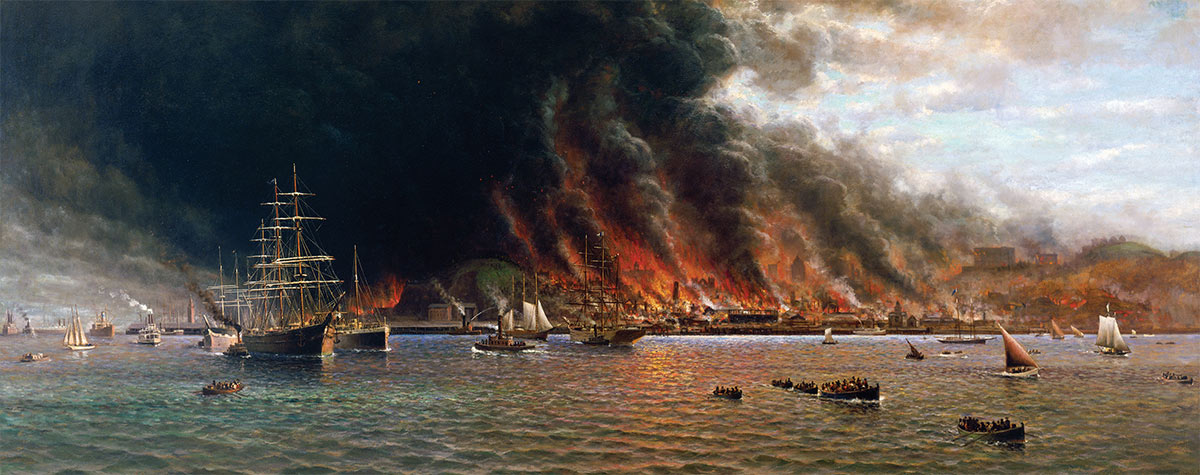
|
Oil
painting titled San Francisco Fire, 1906
by W.A. Coulter. The artist's vivid portrayal of
the fire that burned for three days, destroying
thousands of buildings, was first sketched
during repeated trips on the Sausalito Ferry
during the evacuation of the city. Coulter later
completed the painting on a 5- by 10-foot window
shade he salvaged during the fire. Image of
painting courtesy of the W.A. Coulter
Retrospective Exhibition Committee of the Paul
and Linda Kahn Foundation.
Courtesy of the California Department of
Conservation. |
| |
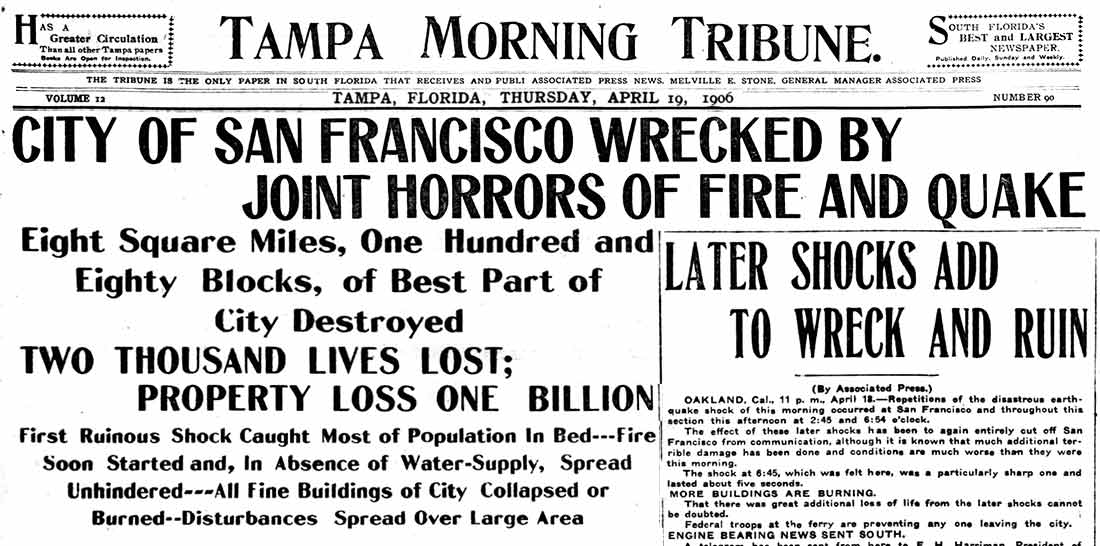
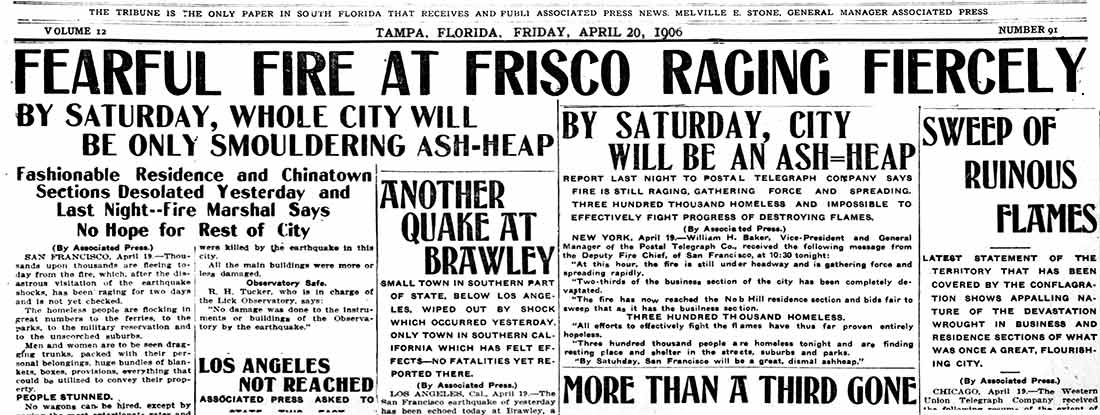
| |
|
|
1906, April 20 -
TAMPANS DISTRESSED BY THOUGHTS OF THE DODGES IN SAN
FRANCISCO
The
Tribune reported that friends of Louise in Tampa
were alarmed by the knowledge that she and her
parents were living in San Francisco. Nobody
in Tampa knew if they escaped the disaster.
Other Tampans such as Judge Donovan, Rabbi Stollnitz
had relatives there. |
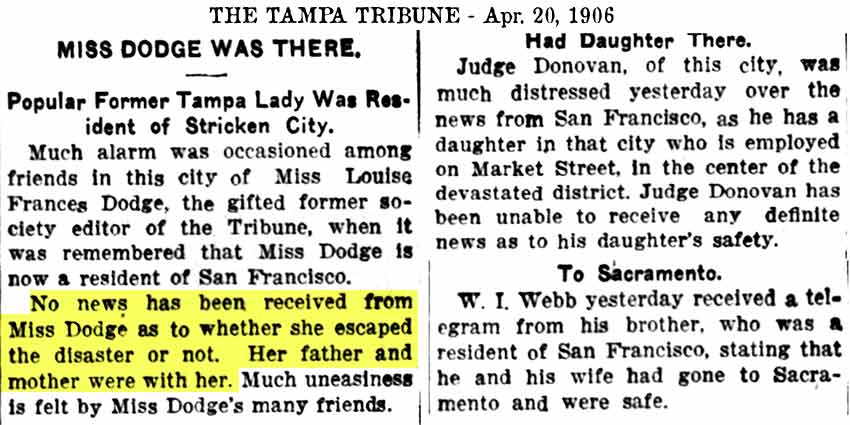 |
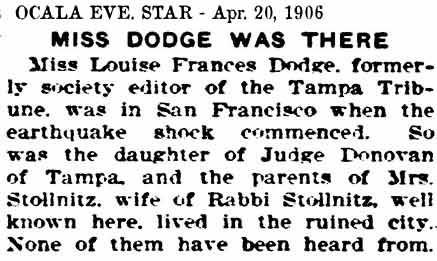 |
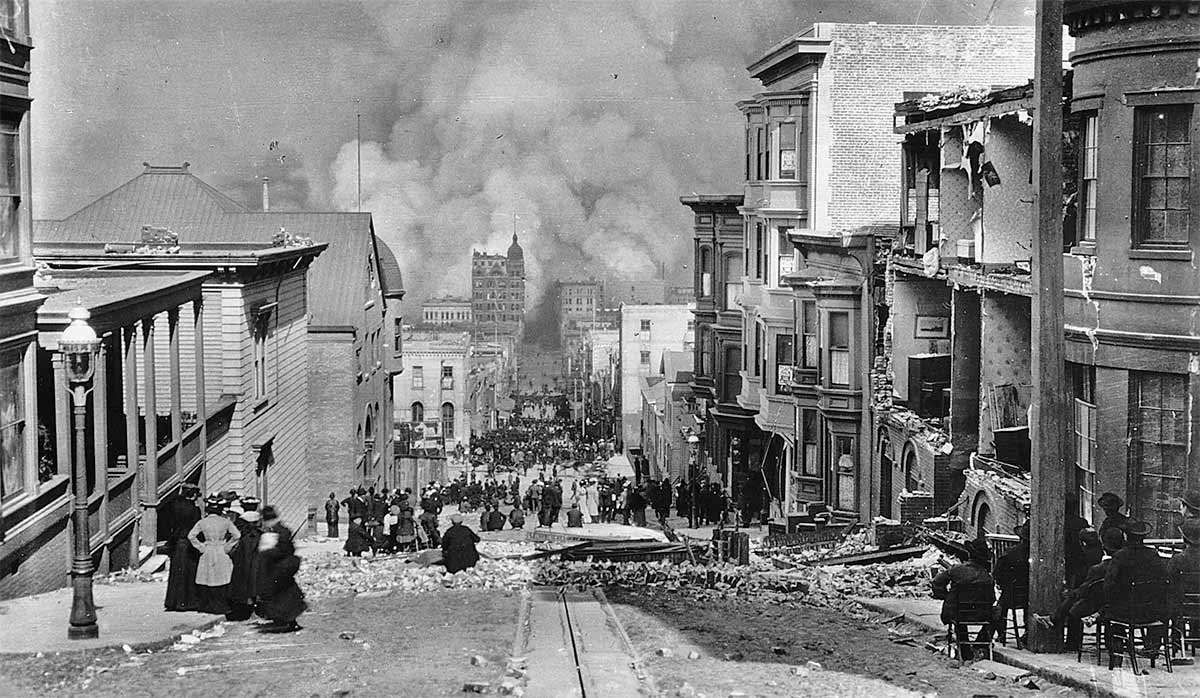
|
Crowds
watching the fires set off by the earthquake in San
Francisco in 1906, photo by Arnold Genthe.
Library of Congress at Britannica.com.
The
night before the 1906 earthquake, renowned Italian
tenor Enrico Caruso performed in San Francisco. The
world-famous opera singer escaped the city’s Palace
Hotel where he was staying at the time of the quake,
however, the hotel itself was destroyed by fire
later that day.

| |
|
|
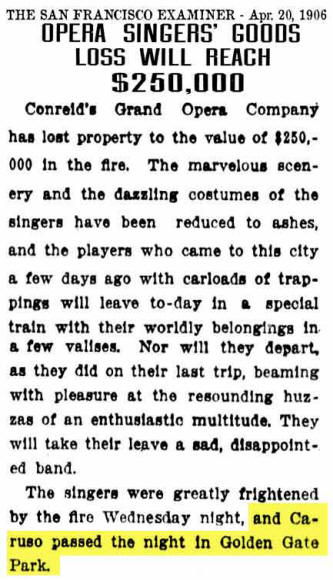 |
The article at left says Caruso spent
the night in Golden Gate Park.
This is where many refugees fled and tents
were set up for them. The article
below claims Caruso was "one of the
first" persons to get across the bay to
Oakland and he gazed from the rear of
the departing boat at the fires "which
had broken forth a few minutes before."
Not possible. The fires
started immediately at the time the earthquake
struck. He could not have boarded
a ferry with seven trunks and baggage
minutes after the fires began,
especially since he spent the night in
Golden Gate Park. Fire and damage
would have prevented anyone from going
near the ferry docks the day of the
earthquake.
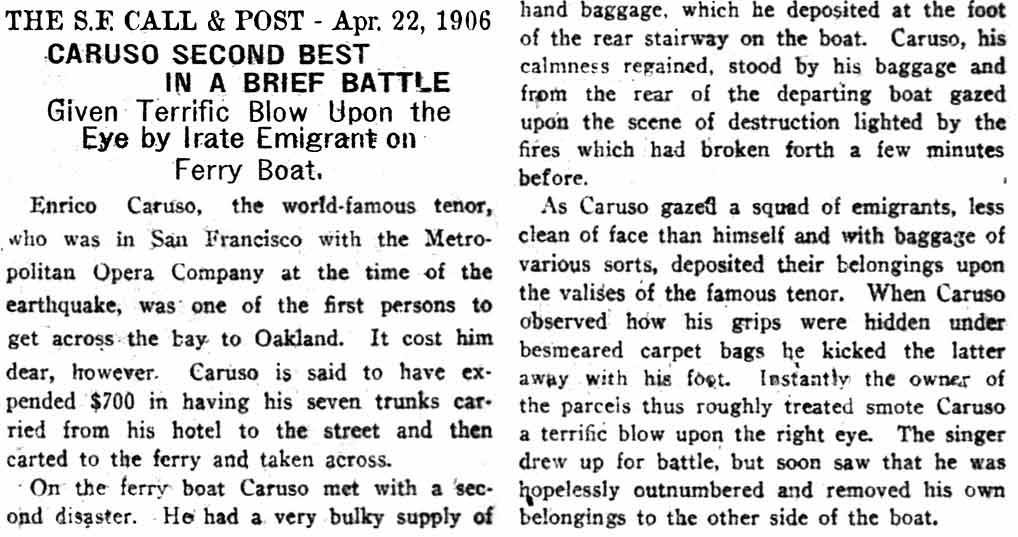 |
THE EARTHQUAKE AND FIRE
Info below combined
from
Britannica.com,
U.S. Geological Survey website and
California Dept. of Conservation.
|
|
San
Francisco had experienced earthquakes in 1864, 1898,
and 1900 but nothing like the 1906 event. At
almost precisely 5:12 a.m. local time on April 18, a
foreshock occurred with sufficient force to be felt
widely throughout the San Francisco Bay area.
A noise "like the roar of 10,000 lions" rose as the
entire city began to tremble and shake. The
great earthquake broke loose some 20 to 25 seconds
later, with an epicenter in the Pacific Ocean just
offshore from San Francisco. Cable cars
abruptly stopped, City Hall crumbled, and the Palace
Hotel’s glass roof splintered and littered the
courtyard below. Violent shocks punctuated the
strong shaking, which lasted some 45 to 60 seconds.
The San Andreas Fault slipped along a segment about
290 miles long and the shaking was felt from Los
Angeles in the south to Coos Bay, Oregon, in the
north, and inland as far as central Nevada. Damage was severe in San Francisco and in other
towns situated near the fault, including San Jose,
Salinas, Stanford and Santa Rosa.
Edison movie footage at Britannica.com from Library
of Congress.
Figure at right shows the extent of the 1906 rupture
seen at the surface. The total length was 296 miles.
For comparison, the 1989 Loma Prieta earthquake had
a rupture length of about 25 miles (blue).
Below is a
seismogram recorded in Gottingen, Germany, 5,654
miles away. It shows how the ground moved in Germany
as a result of the 1906 San Francisco earthquake.
Small wiggles, beginning 1/2 inch from left end,
signal arrival of first compressional (P) waves.
Large wiggles half way along represent arrival of
slower-traveling shear (S) waves. The part of the
record shown here spans about 1600 seconds or 26
minutes. The instrument subsequently went off-scale
when surface waves arrived.

Bill Ellsworth, U.S. Geological Survey website.
Images courtesy of same site.
The
quake was followed by a massive fire that swept from
the business section near Montgomery Street and the
south of Market district toward Russian Hill,
Chinatown, North Beach, and Telegraph Hill. The
blaze continued for four days, until its smoldering
ashes were ultimately extinguished by rain. In the
process, more than 500 blocks in the city
center—covering some 4 square miles (10 square
km)—were leveled. The inferno destroyed some 28,000
buildings, and the total property value loss was
estimated at $350 million. Some 700 people
originally were thought to have died in the
disaster, but the death toll is now believed to have
exceeded 3,000. Moreover, about 250,000 were left
homeless; survivors camped in Golden Gate Park and
dunes west of the city or fled to outlying towns.
BELOW: 1906 American
Company map with Burton & Rey map of burn district
superimposed from
Boston Rare Maps collection. Red lines in the burned
district indicate the fire paths.
It is important to know about maps such as these
and what is said about the maps at Boston Rare
Maps.
|
Just as today, the American
public was fascinated by mayhem, and
publishers churned out a flood of
imagery depicting the destruction of
San Francisco. ...If anything, the
map understates the extent of the
destruction: the burnt district
was among the city’s most densely
populated, while much of the area
shown had been laid out for
development but was at most lightly
inhabited. |
This was a
city PLAN map and not necessarily what
existed. Many of these outlying subdivisions were barely
developed, sparsely inhabited, without
paved streets, or completely undeveloped sand
dunes,
especially the hilly areas. Many of the streets
did not yet exist nor were they developed for many years.
The numerous map makers who capitalized on the
destruction used maps created from city planning maps as their
basis.
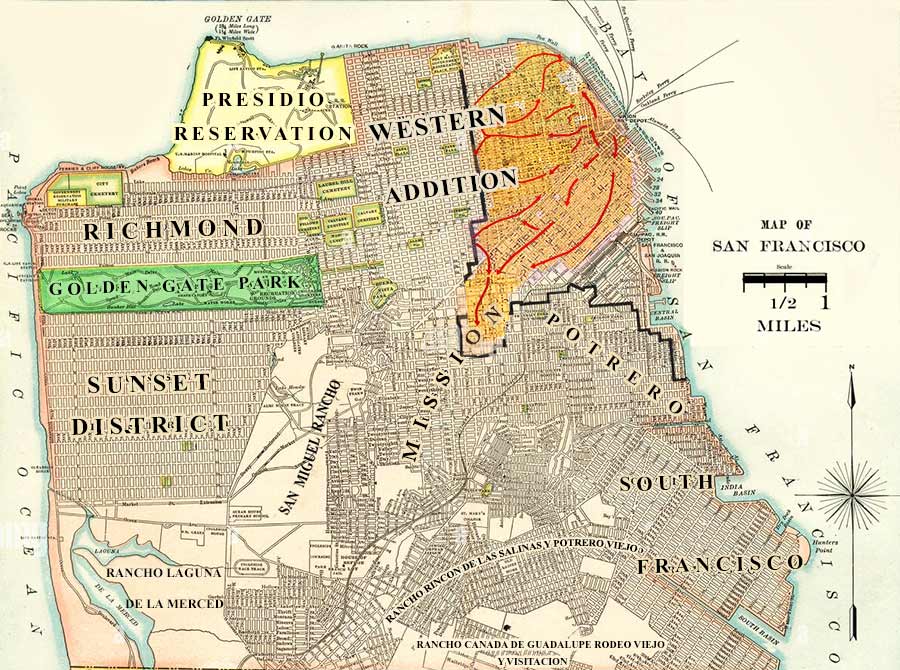
Red lines indicate the
progression of fires.
Earthquake and fire map animations showing
progressions of shaking and fire.
USGS Map showing areas of highest ground
acceleration
|
LOCATION OF SAN ANDREAS FAULT &
PERCEIVED SHAKING OF 1906
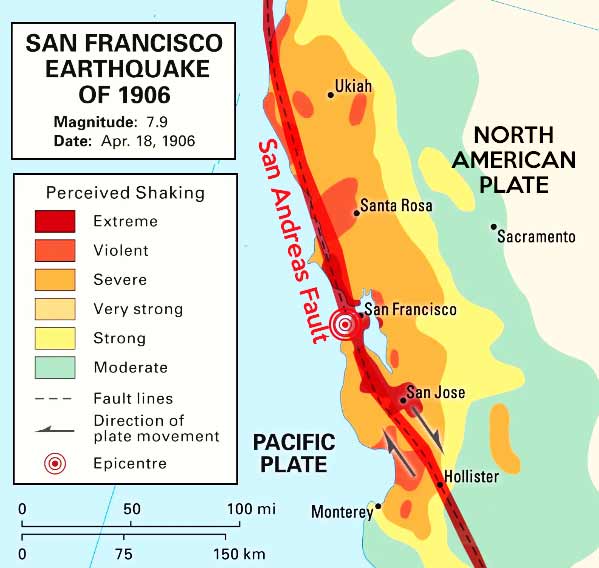
Wide range view
of greatest
ground acceleration and the San
Andreas Fault 1906 quake epicenter. The
shaking was more pronounced on the west
side of San Francisco. USGS Map. |
The
burned district map below is an altered
version of one from the
California Dept. of Conservation
website. It is a modern
day base layer map as evidenced by the
SF- Oakland Bay Bridge. There were
no bridges across the bay until the
1930s. TampaPix has added
overlays showing the location of
the Union Ferry Depot and ferry routes
from 1906 and other landmarks. The
towering depot is one of the iconic
photos of devastated SF. The stars mark the start
points of the major fires. See
below for the "W."
SEE THIS MAP FULL SIZE
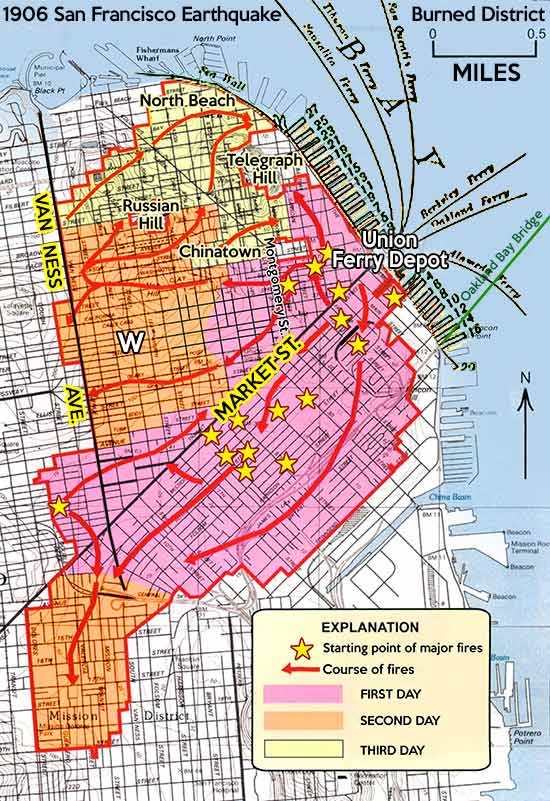
HISTORICAL ACCOUNTS: Mrs. Eleanor Watkins
was the wife of a San Francisco surgeon.
Excerpts of her eyewitness account of
the quake and the fire from her home (W) can be found on the California
Dept. of Conservation website along with
amazing photos which are displayed
larger when you click on them.
Read Mrs. Watkins' description of the
disaster. |
|
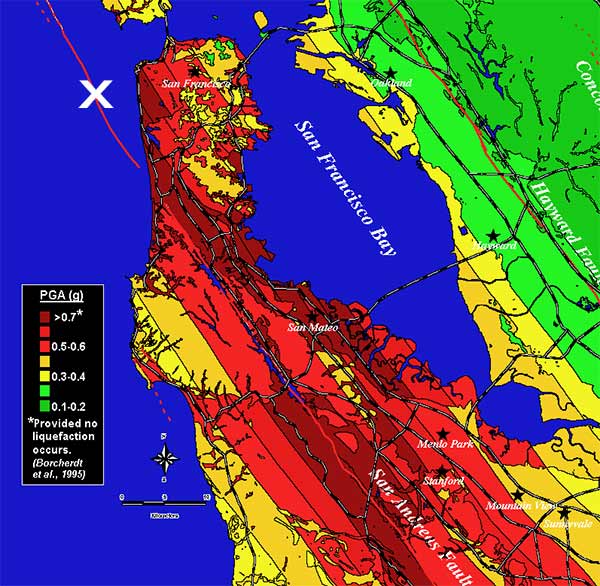
Gallery of Photographs Related to
the 1906 San Francisco Earthquake, Fire,
and Refugee Camps shows most of the tall
downtown area buildings did not suffer
catastrophic damage from the earthquake
itself. Damage from shaking varied
due to construction type and soil
makeup.
|
Earthquake shaking intensity map
from
ResearchGate.net by S. Tobrinner.
Color has been added to original B&W image.
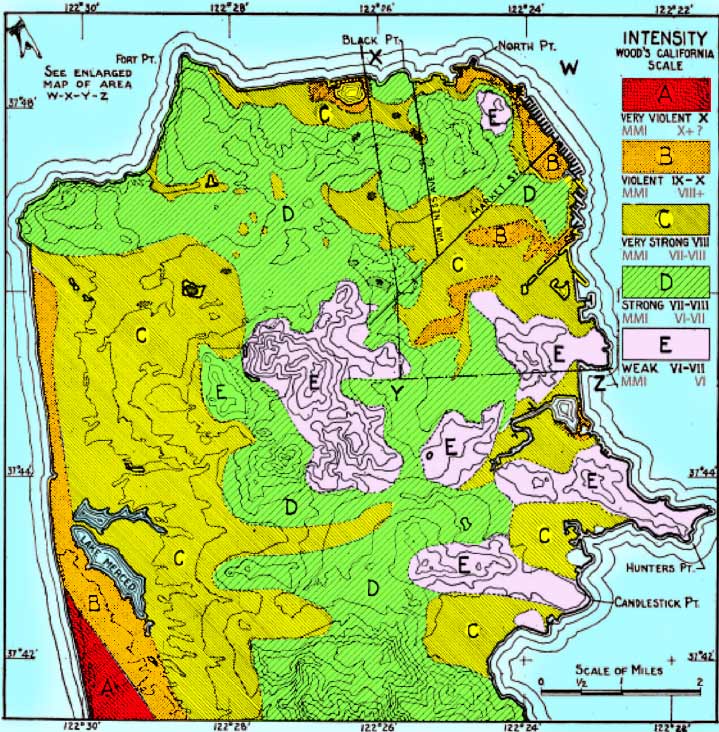 |
1906, April 25 - A letter was received by Mrs. Brash which Louise
sent on April 16, two
days before the quake.
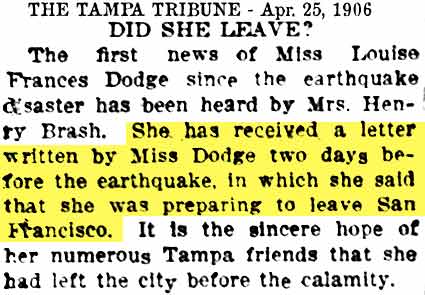 |
1906, April 28 - The
Dodges were safe at a nearby mountain resort. The
article claims that Louise and her parents left SF
two days before the disaster, but Louise's report to
the Tribune written Apr. 29th (see below this
article) says she was in SF the
day of the earthquake.
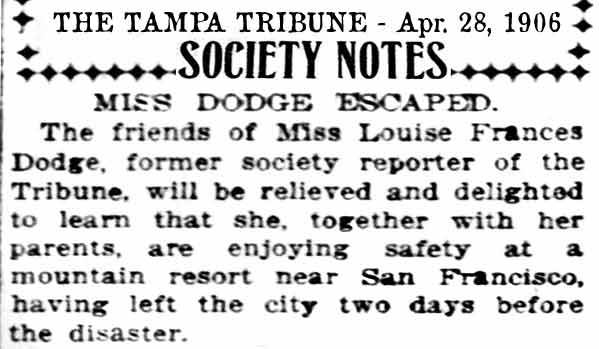 |
1906,
MAY 8 - REPORT
FROM MISS DODGE DESCRIBES THE DISASTER
A
description of the disaster written on April 29th by
Louise Dodge from
Camp Meeker was received by the Tribune. It
was written "more than 10 days after the disaster"
which took place on April 18. It is important
to note that the events she
described were NOT in chronological order.
The blasting of the buildings she refers to was the
fire department blowing up buildings to create a
"fire break" hoping to prevent the fire from
spreading. There was no water to fight the
fires, the water mains were shattered by the
earthquake.
|
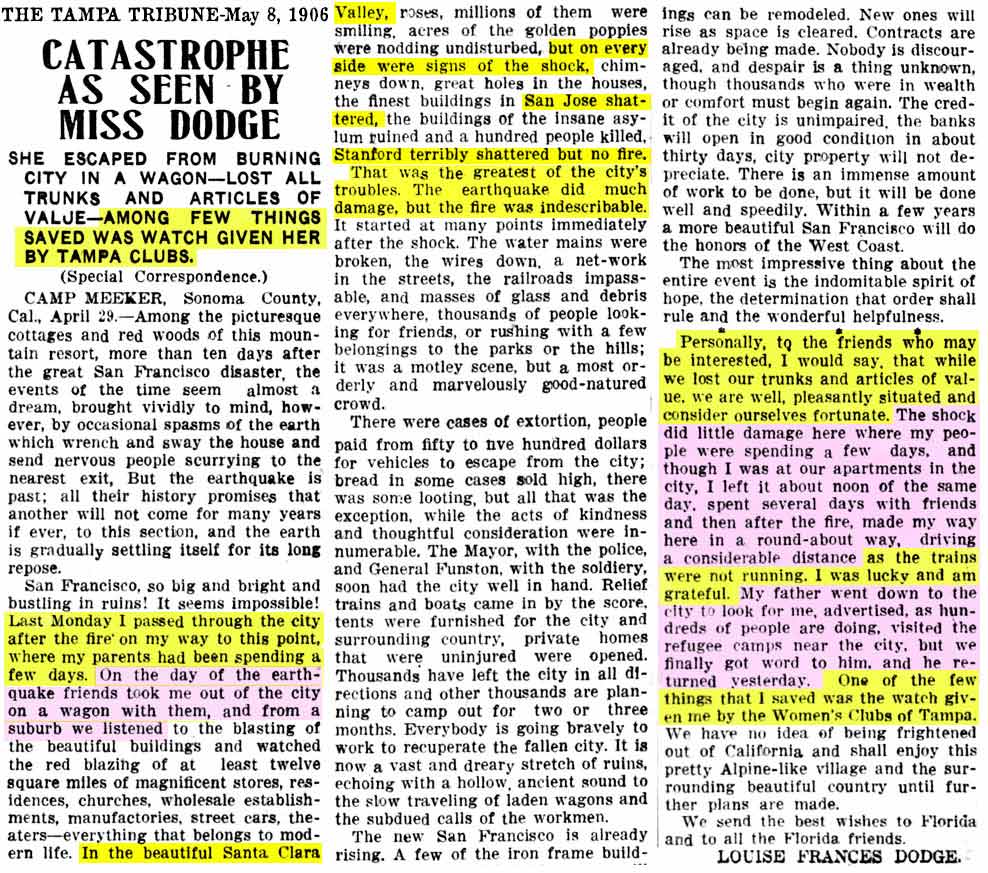
|
|
UNDERSTANDING THE ARTICLE
"Last Monday I
passed through the city after the fire on the way to
this point where my parents had been spending a few
days." Louise refers to Monday, Apr. 23,
five days after the earthquake, one day after the
fires were out, and five days before
writing this letter from Camp Meeker.
So where was she before she passed through the city
last Monday the 23rd? Her passing "through the
city" was not necessarily through the fire damaged area and was
more likely a passing through the suburbs on the
outskirts of the business district.
In
the next sentence of the same paragraph she
backtracks five days to the day of the
earthquake.. "On the day of the earthquake friends took me out
of the city on a wagon with them, and from a suburb
we listened to the blasting...and watched..." She was in
San Francisco the day the quake hit. Her use of the phrase
"out of the city" doesn't seem to mean out of San
Francisco, but instead away from the central business
district which was on fire.
Recall that in the
April 25 Tribune article about the letter received
by Mrs. Brash which Louise wrote two days before the
quake (the 16th), Louise stated she was
"preparing to leave San Francisco."
Now in this article, she says she was taken out of
the city the day of the earthquake. It
might be that she planned to leave with her
parents on the 16th to go to Camp Meeker where they were to spend a few days,
but either went there and returned, or remained in
the city and only her parents left.
In
the same paragraph, she immediately goes on to
describe the beauty of the Santa Clara valley fauna
along with great damage in San Jose and Stanford. "...but on every side were signs of
shock.." At this point she has traveled a
good 15 miles or so southeast of the city of San
Francisco and was on her way to Camp Meeker. |
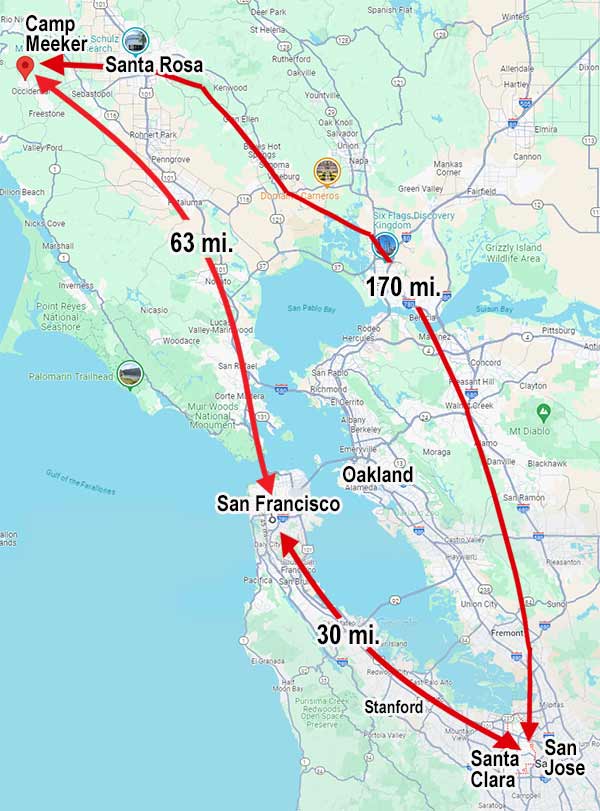
"We lost our trunks and articles of value..."
This would have been whatever was left behind in their
apartments, indicating she could not or did not go
back to retrieve anything. |
|
"The shock did little damage here where my
people were spending a few days..."
She refers to her parents at Camp Meeker.
...and
though I was at our apartments in
the city, I left it about noon the same day, spent
several days with friends, and then after the fire
made my way here in a roundabout way, driving a
considerable distance." She doesn't say what day she's
referring to when she says "...the same day..."
She could mean the same day her parents left for
Camp Meeker, but more likely she backtracks,
referring again to the day of the earthquake, but in
more detail, then she skips to Monday, the 23rd, after
the fires when she left the suburbs and made her way
to Camp Meeker. This would be when she witnessed the
damage in Stanford, Santa Clara and San Jose.
This trip
would have started on Monday, Apr. 23 from the
suburbs, "driving a considerable distance, as
the trains were not running." through the Santa Clara valley, and on up
to Camp Meeker. She doesn't say SHE drove, nor
does she say that the trip was driven the entire
way.
"My father went down to the city to look for
me...visited the refugee camps near the city, but we
finally got word to him and he returned yesterday."
There were no bridges across the bay, the Oakland
Bay bridge opened in 1936, the Golden Gate didn't
open until 1937. Below is evidence he was in Oakland.

This
was among hundreds of personal ads in this newspaper
by persons looking for friends and relatives or
persons announcing they survived and were trying to
get word to others of their location.
See The History of Transportation in San Francisco.
Louise doesn't say when she got to Camp Meeker, but
it seems that at some time after her return they
were able to get "word to" her father who
had gone looking for her. He returned on the
28th.
"One of the few things that I saved was the watch
given me by the Women's Clubs of Tampa."
You
will hear of this watch again fifty years later.

People
watching from suburb hillsides as downtown San
Francisco burned.
Gallery of Photographs related to the 1906 San
Francisco Earthquake, Fire, and Refugee Camps shows
many of the downtown area buildings did not suffer
catastrophic damage from the earthquake itself.
PROBABLE SCENARIO
The
most probable chronological scenario is that Louise was planning
to leave SF with her parents on the 16th as evidenced by her
letter she sent to Tampa two days before the
disaster. She could have escorted them
there, then come back into SF, but more likely she changed her plans and only her parents left. On
the morning of the earthquake, the 18th, she was somewhere
in San Francisco's Western Addition or near the business district in her
apartment. (The earthquake started at
5:12 a.m. so she was probably in her apartment,
sleeping. ) By noon
she was taken by friends on a wagon to an area
in the suburbs where they watched the business
district burning. This was probably somewhere in the
Western Addition in the direction of Golden Gate Park and
the Presidio. She didn't mention where she
stayed for those five days except that she was with
friends.
On the
22nd, rain put out what was left of the smoldering
ashes. On
Monday, April 23 when the fires were out she drove
or was
driven from the suburb in sight of the earthquake
ruins along the west side of the burnt district and
southeastward parallel to lower San Francisco Bay
through Stanford, Santa Clara and San Jose.
Louise said the trains were not running.
Then
she went
from Santa Clara around the south end of SF bay,
northwestward, probably in the vicinities of
Oakland, Berkeley, San Pablo, Napa, Santa Rosa and
finally Camp Meeker. If she was driving, it
probably would have been her own car, if she had one.
This would have been unlikely because she had
to be taken out of the city on a wagon, thus leaving
any car she owned.
However, if she lived outside of the burn district
west of Van Ness Ave., she could have retrieved it,
though she makes no
mention of going back to her apartment. Having lost
their trunks and valuables, it is doubtful she was
able to gain access to the inside of her apartment.
It probably did not burn but may have sustained structural
damage.
Some
time around the 22nd to 25th, her father came down
from Camp Meeker to look for her. Somewhere in
the surrounding area of SF, he put an ad in
the newspaper and waited at the Oakland Post Office.
Probably not seeing it, Louise arrived in Camp Meeker
somewhere around the 25th or 26th. Mr. Dodge
had probably made plans with his wife of where he
could be contacted if Louise arrived before he did.
Having received word she was at Camp Meeker, Mr.
Dodge returned on the 28th.
Louise
mentions having lost all their trunks and valuables
and she probably didn't mean empty suitcases.
Valuables probably meant more than just jewelry.
Their apartment could have been a boarding house or
apartment building as they had not been in SF for more than
five months when the earthquake hit. Later,
you will see the importance of the fact they lived
in an apartment and did not own their own home. |
See interactive map of damaged areas of San Francisco.
Click on an orange area to see photos of damage in that area.
Very large panorama of burnt district at Wiki
Movie
footage at Vimeo
Evacuation of San Francisco by Southern Pacific Railroad
|
THE
DODGE FAMILY AFTER THE EARTHQUAKE
The
Dodges were listed on the 1909 San Francisco city
directory living at 1457 Franklin. The "r" denotes
this is a residence. This directory
did not list spouse's names. At this time Mr.
Dodge was 73 and Louise was 34.
This
location is a business and condos/apartments area today and located just
one street west of Van Ness Avenue, an area
which was not damaged by the fire in 1906.
It is possible this was where the Dodges lived
before the earthquake. Compare 1905 and 1913
Sanborn maps to follow below.
|
|
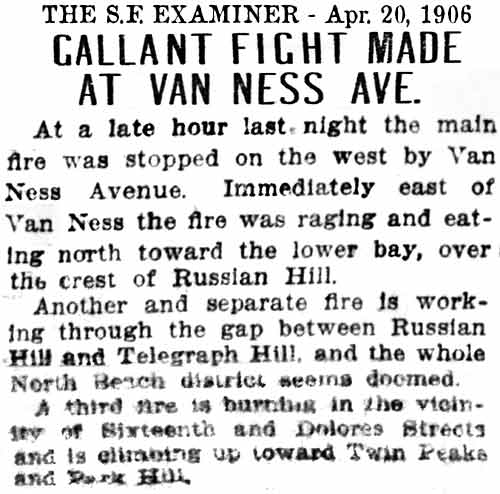 |
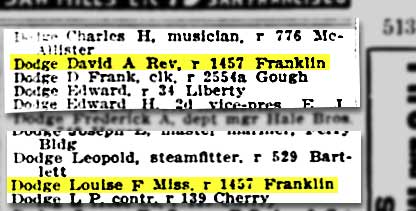 |
|
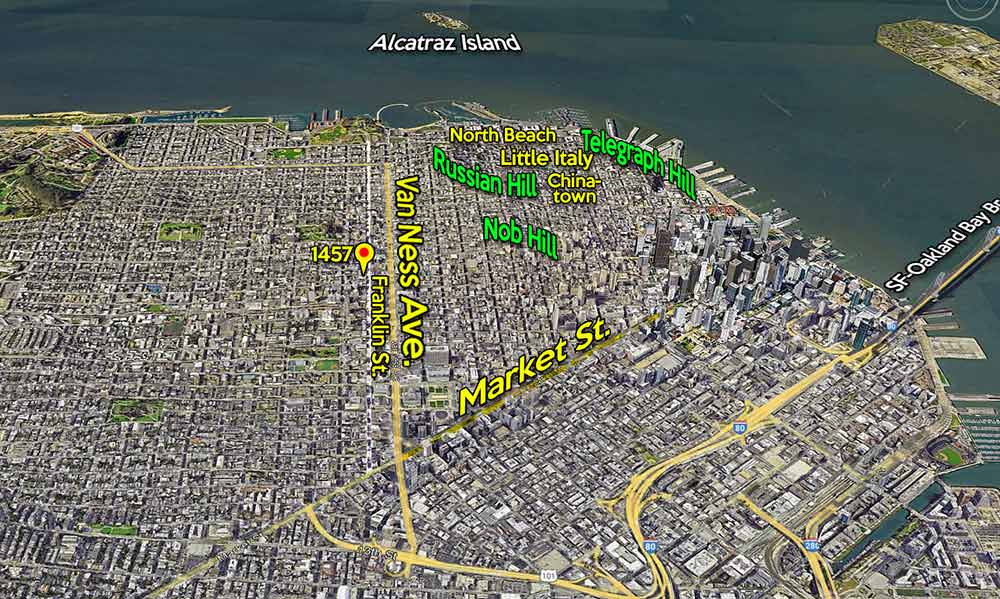
The close-up below shows the area today is overrun by
condos and apartment buildings.
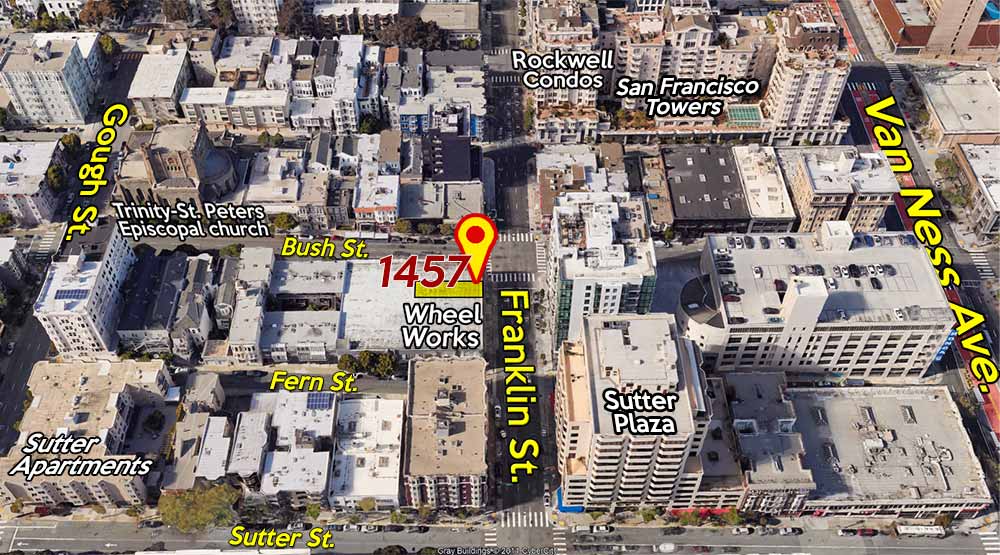
The
David Rumsey Map Collection contains
extremely rare map images of pre-earthquake San
Francisco from 1905. The pages are brown
and heat damaged.
Below is enhanced and rotated (it was upside down
with north at the bottom) from the
David Rumsey Map Collection 1905 Sanborn Fire
Insurance Map San Francisco - pages 257 & 258 The
blocks have been moved closer together to conserve
space and present them as large as possible.
The red rectangle marks the address where the Dodges
lived on the 1909 San Francisco City directory.

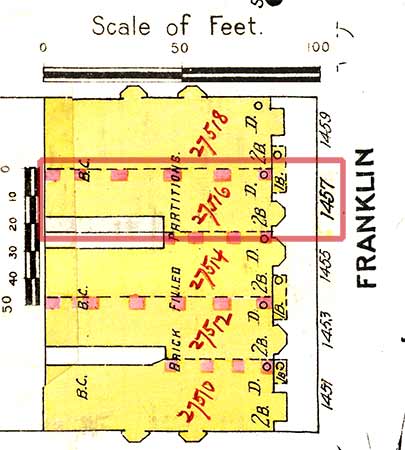
The numbers in red inside each dwelling appear to be
property numbers. The Dodge's dwelling was about 80 ft x
20 ft and was 2-story with a basement. The
units were separated by brick-filled partitions.
This
1913 Sanborn Map from Library of Congress shows
the building where the Dodges lived wasn't destroyed
in the earthquake and appears to have remained
unchanged. They may have lived there when they
first arrived in San Francisco in late 1905, and
could have moved right back soon after the April
1906 earthquake. This area west of Van Ness
wasn't damaged by fire. However, the mirror
image building across Franklin St. was gone (X).
TampaPix has altered this map by moving the blocks
much closer together. The streets were
actually about as wide as the blocks, except for
Fern St. which was about half the width of the other
streets.
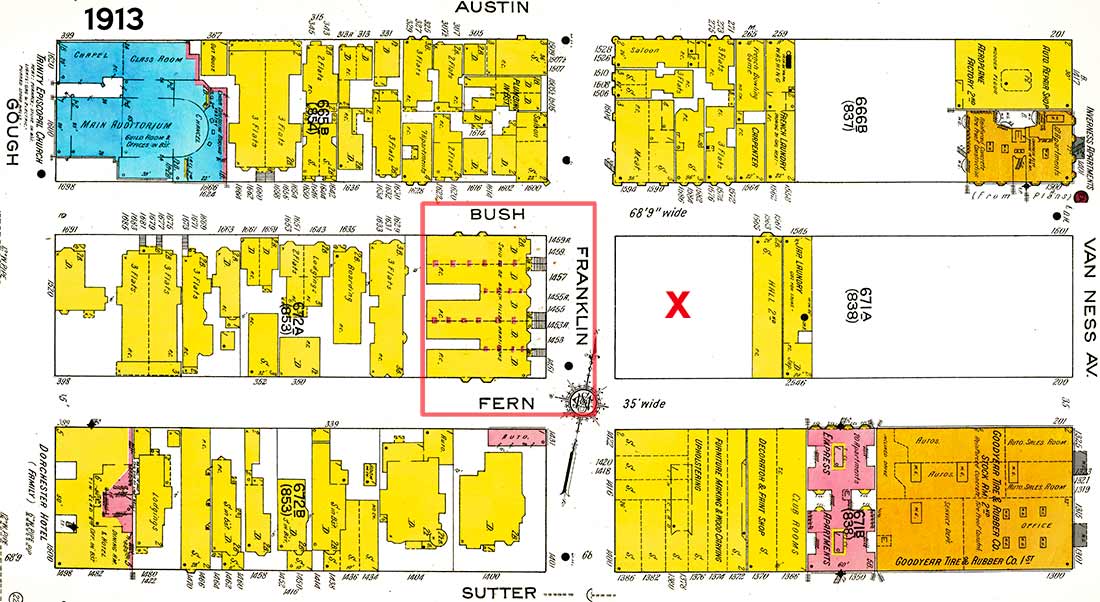
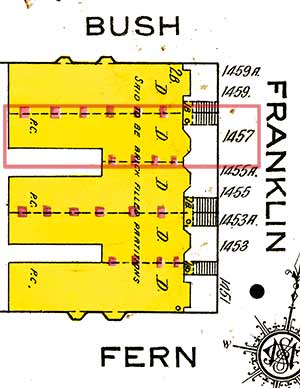
The
Dodge's apartment building has the footprint of the
commonly used row house style for many
San Francisco dwellings of the period. A
terrain-view map shows this area with sloping
streets downward from west to east.
Below:
San Francisco earthquake of 1906 - Row houses in San
Francisco, tilted by soil liquefaction after the San
Francisco earthquake of 1906.
From Encyclopedia Britannica.
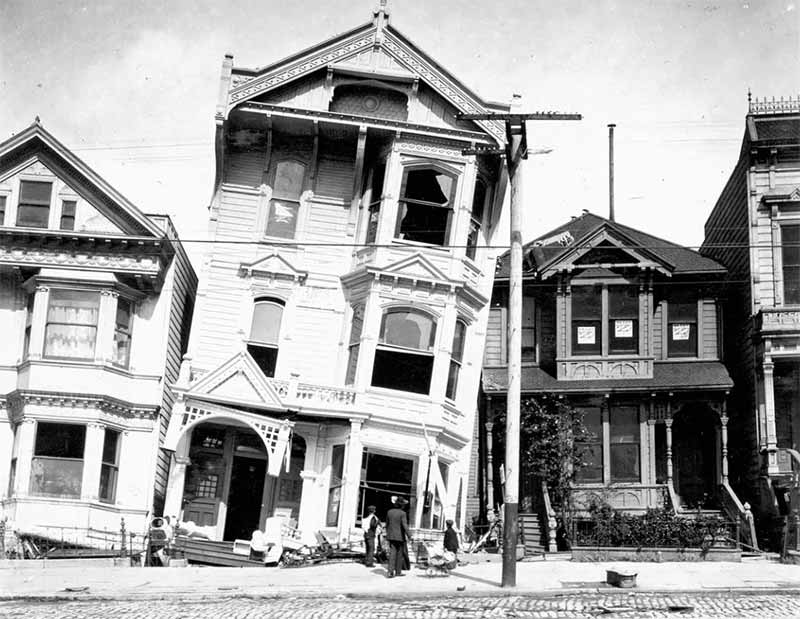
|
|
THE DODGES ON THE 1910 CENSUS
In
April of 1910 David & Helen Dodge were still living
at 1457 Franklin St., but Louise was no longer
living there. Mr. Dodge
was a retired clergyman and Mrs. Dodge worked as a
housekeeper in a lodging house. They were in
their early 70s and had been married 44 years.
|
|

1910 CENSUS - LOUISE IN ST. LOUIS
By 1910
Louise had moved to St. Louis, MO and is found on
the 1910 Census there as a lodger in the home of
Michael Cultner and his family.
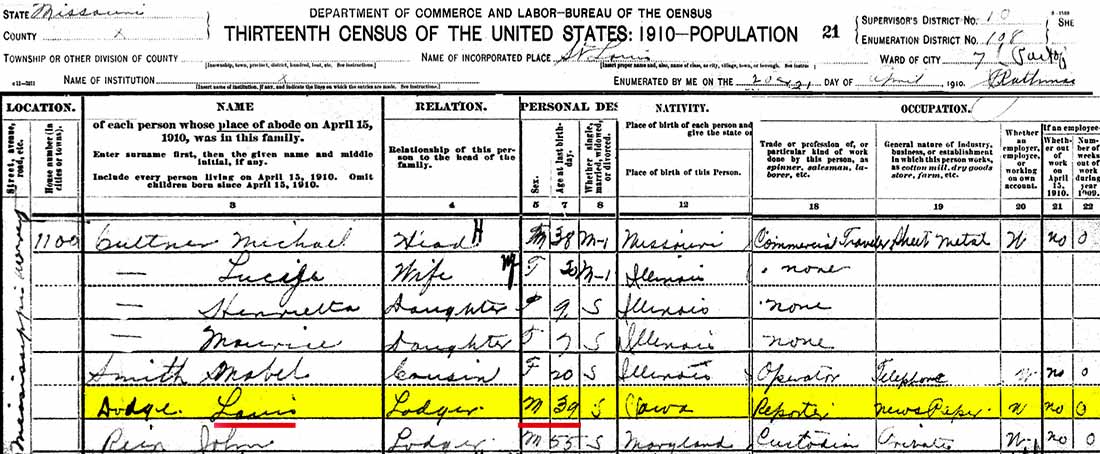
There
are four errors on her entry here: She was
listed as "Louis," male, and age 39. Louise
would have been 35 in 1910. The columns for
nativity of her parents have been edited out to
conserve horizontal space. It showed her
father born in New York, which is correct, but her
mother born in Iowa--incorrect. Helen Dodge was born in
Michigan. All these problems can be a result
of enumerator error and the info not being taken
from Louise herself. With so many errors, how
can we know this was actually Louise? She had been
there in 1904 to attend a woman's club convention
and the St. Louis World's fair, as well as the
Olympics. But the
best evidence is "Louis's" occupation:
NEWSPAPER REPORTER. Was she a reporter because
that used to be her career, or was she currently
working as a reporter? The last
two columns answer this: #21-Whether out of
work on Apr. 15, 1910: "No." #22 -
Number of weeks out of work during year 1909:
"0."
1913 - DODGES OWE $2.50 IN TAXES FOR PALMER UNION
OIL STOCK
This
article of Aug. 29, 1913 listed thousands of
stockholders who owed a tax on their shares.
The fact they owned stock shows that David & Helen Dodge
were at least depending on investment earnings for income.
Recall also that David also was receiving a pension
for being disabled in the Civil War.
Each owned 125 shares of Palmer
Union Oil Company common stock and owed $1.25 each,
indicating a penny per share tax. The Fed
began taxing income in 1913 so this may
have been a federal income tax assessed on the
company which was being passed to the stockholders.
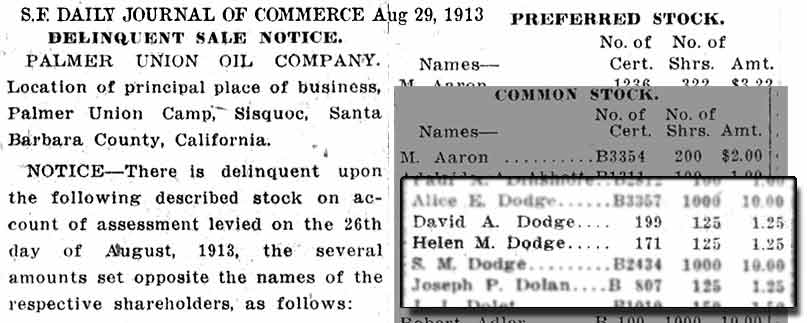
Palmer Oil Company - Oilfield discovery in 1908 at
Cat Canyon, CA, began company's lengthy corporate
convolution.
The search for oil and natural gas began in 1904 at
Cat Canyon in the Solomon Hills of central Santa
Barbara County, California. Exploration
companies unsuccessfully drilled there for four
years before Palmer Oil Company discovered an
oilfield about 10 miles southeast of Santa Maria.
"Oil Age Weekly” on September 9, 1910 declared, “The
Palmer Oil Company is generally concluded to have
opened one of the biggest and richest oil fields in
California by the bringing in of its two gushers in
the Cat Canyon District, now doing 10,000 barrels
per day between them. The success of Palmer Oil
brought new investors, and the company was
capitalized at $10 million by the beginning of 1911.
1913: WORST YEAR EVER
Perhaps the most forgotten period in American
economic history is the eight years that followed
the creation of the Fed and the income tax in 1913.
From 1913 to 1921 the growth rate came in at just
1.4 percent per year. The period included two long
recessions: one beginning in 1913, in which that
year’s level of production was equaled only two
years later (and with the assistance of military
production that did nothing for living standards),
and another from 1919 to 1921 that was simply the
worst depression the nation would ever suffer
outside of the 1930s. The new income tax system hit
persons making as little as $1,000 a year ($11,000
in today’s terms).
|
|
1914 Sep. 8 - LOUISE DODGE BACK IN CALIFORNIA AT
BERKELEY BY SEP. 1913.
Louise was on the decoration committee for the
University of California's sophomore hop
(dance.)
Being that Louise was a sophomore in the fall of
1914, she could have been a freshman starting in
the fall of 1913.
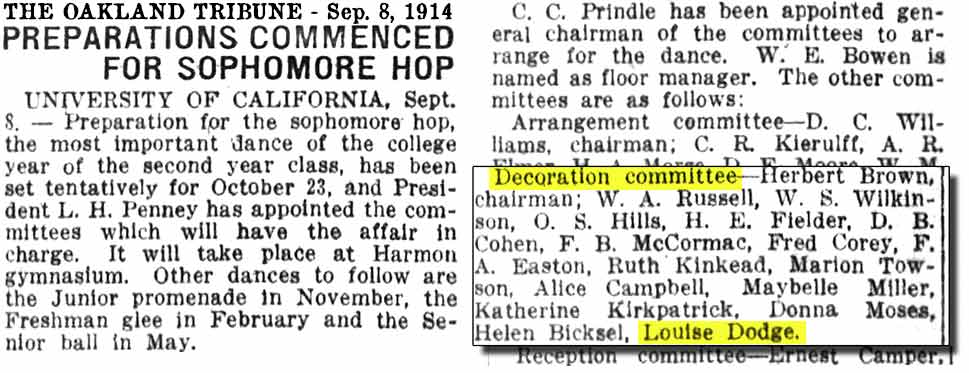
SENIOR WOMEN
REMOVE THE BAN ON PROGRESSIVE DANCING ON CAMPUS
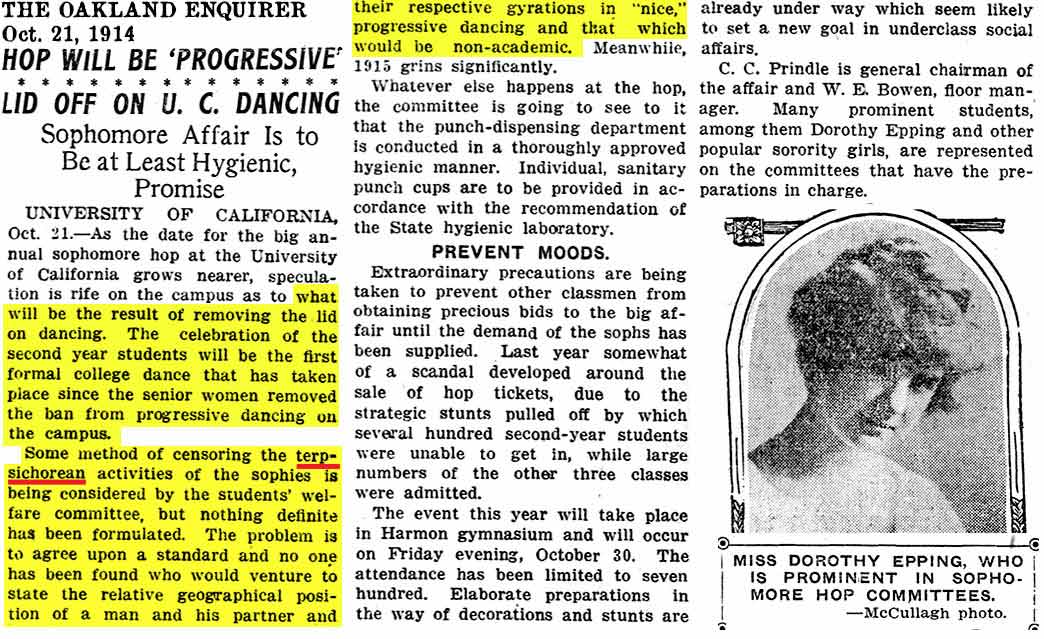
|
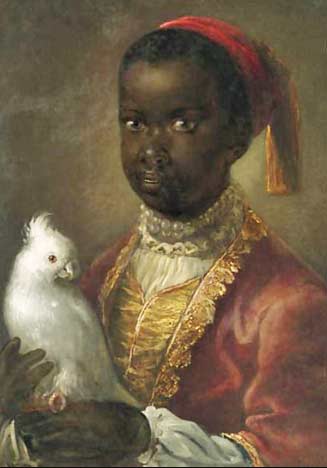
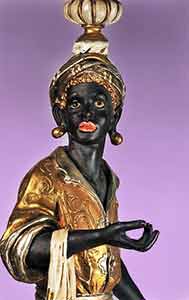
1915 Apr. 9 -
LOUISE DODGE PARTICIPATES IN UCAL'S FOURTH ANNUAL SPRING FESTIVAL
Louise participated in the spring festival celebration dressed as a "Blackamoor,"
a style of decor and character portrayal
considered to be a racist stereotype today.
Blackamoors are usually presented as ornately
dressed servant figures bearing light by holding
a candle, candelabra or torch, or the figure may
be holding up a tabletop or carrying a basket of
fruit. “Blackamoor.”
Merriam-Webster.com Dictionary
The
article below has been shortened by showing
only the first three or four lines of names for each
character portrayal. |
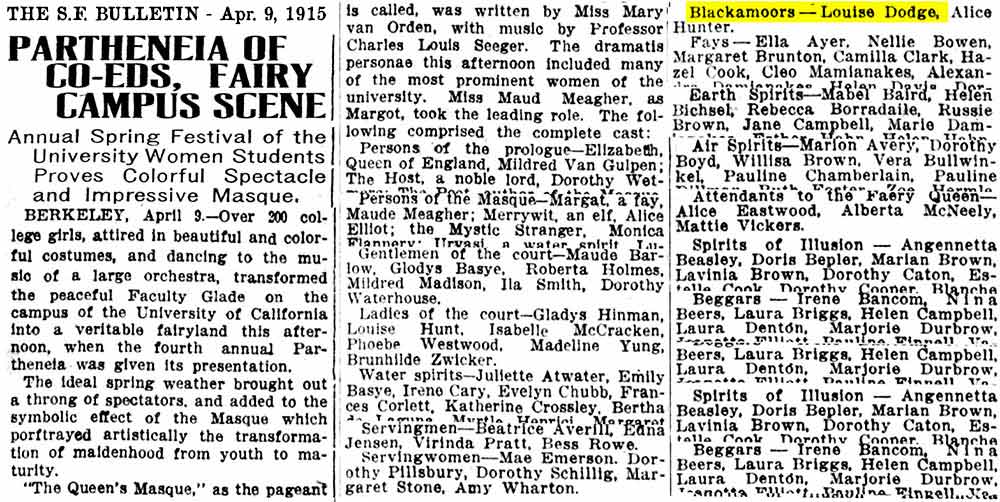 |
|
 1917,
APRIL 1 1917,
APRIL 1
Louise entertained guests at her home at 2204 Dwight
Way in Berkeley
with a dinner party for her birthday. Three
male students from the university attended, along
with her mother and Mrs. Ruf. Louise was 42.
|
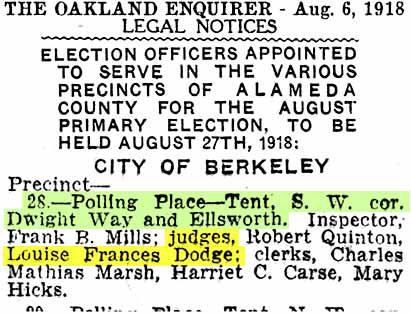
Louise
served as a Precinct 28 polling place judge at the
southwest corner of Dwight Way and Ellsworth for
Berkeley city elections in Aug. 1918, June 1919,
Apr. 1920, Aug. 1920, Oct. 1920, and Jan. 1921. This
was a tent just down the street at the next corner.
2204
Dwight Way today, on the right.
Today this property is
assessed at nearly a million dollars
.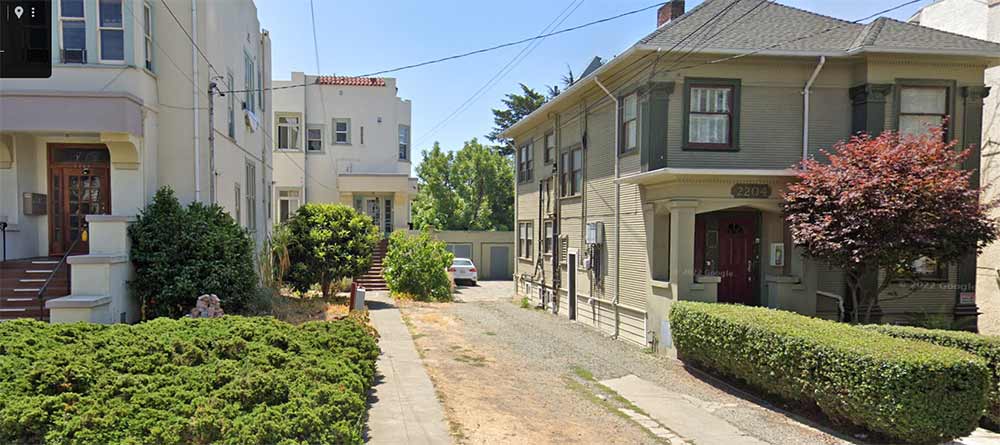
The
1911 Sanborn Fire Insurance map below has been
rotated to match the view of the
house photo above. South is at the top of the
map. The house today appears to have the same
footprint as it did in 1911 and could be the same
house.
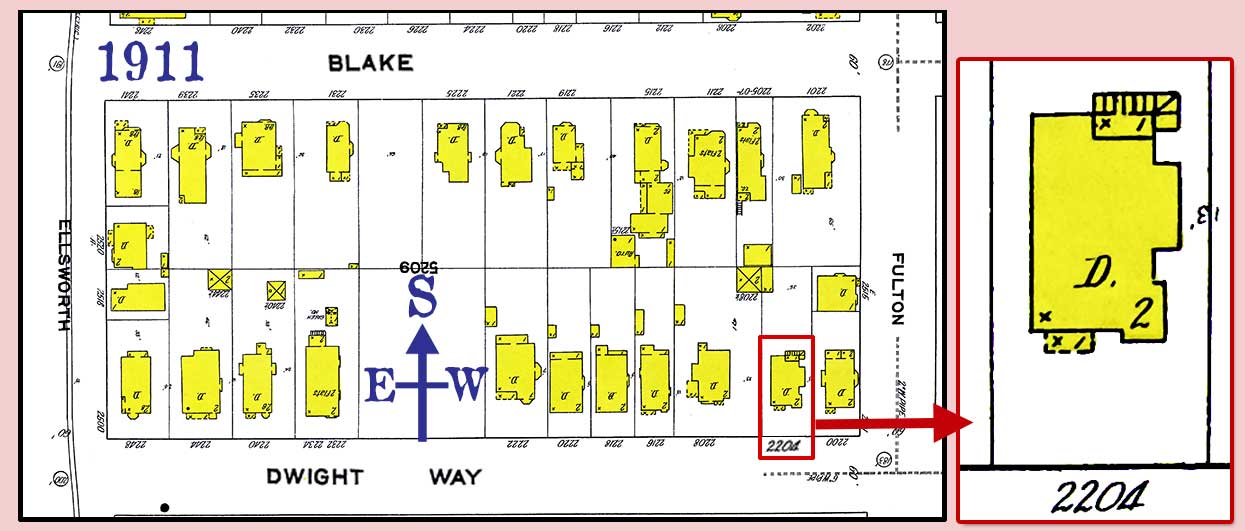 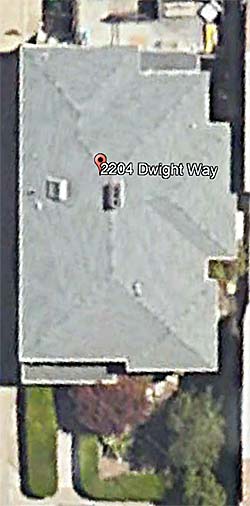
Map courtesy of Library of
Congress
1919, July 31
MR. & MRS. DODGE
CELEBRATE THEIR 54 YEAR WEDDING
ANNIVERSARY
This article gives an accurate biography
of David A. Dodge, but not of Mrs.
(Helen Mills) Dodge.
-
Married in Adrian, Michigan in July
1865, at the close of the Civil War.
-
Mr. Dodge served as a captain in the
18th Michigan Infantry.
-
For some years he was an attorney in
Waterloo, Iowa.
-
Later he entered the Presbyterian
church ministry in Michigan and
Florida.
-
One daughter, Miss Louise Dodge, is
a well-known newspaper woman, having
been with the Tampa Tribune.
-
INCORRECT: Mrs. Dodge is a
descendant of an old New England
military family...etc.
It is Mr. Dodge who is a descendant
of the old New England military
family through his mother,
Ruth
Freeman Dodge. She was a
descendant of Ebenezer Learned, an American
Revolutionary War veteran.
-
The Dodges came to California in
1905.
|
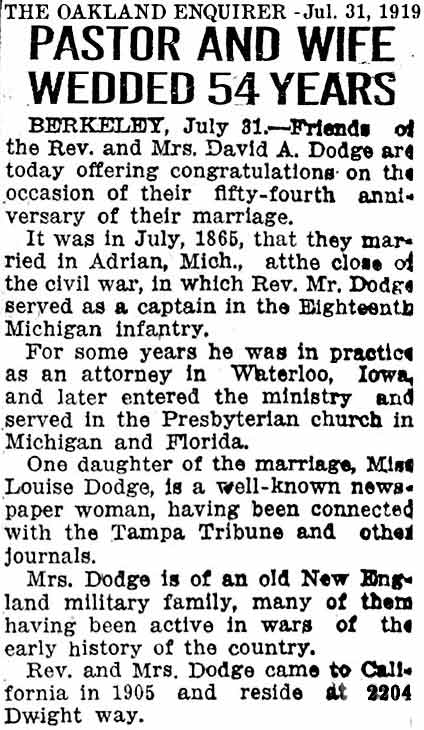 |
1920 CENSUS OF BERKELEY, ALAMEDA COUNTY, CALIFORNIA
2204 Dwight Way -
David A. Dodge (83), Helen M. (82), Louise (44)
single.
None had an occupation; they were renting their
home ("R" in column 7)
This is a large dwelling and they were probably only
one family of multiple apartments.

The census date was Jan. 1, so Louise would turn 45
later in April. |
LOUISE ASSISTS
IN PROMOTING AN EVENT FOR A NEW MEN'S SOCIAL CLUB, THE
AGNETIAN CLUB
In 1920 Louise
was a member of the Young Ladies' Auxiliary and helped to
promote the new Agnetian Club's first social event.
The club was named for its location in St. Agnes Parish, a
Catholic church district.
|
1923,
July 12 - This Tribune article claims Louise had become
interested in politics and held several offices in Berkeley
and had become well-known in musical circles as an assistant
pipe organist at Trinity Methodist church in Berkeley. The complete name of this church was "Trinity Methodist Episcopal church of Berkeley."
No article of their organists or musical programs
was found.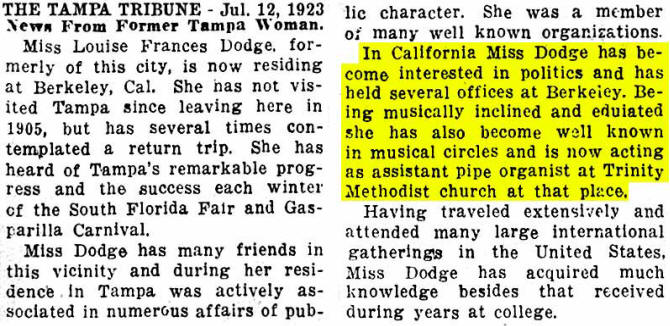
No article could be
found that mention Louise in any civic or political
office, or a church's music program. |
1923, July 27 -
Louise reported about the fires and wind storms that
swept up and down the coast of California in 1923.
She was remembered in Tampa as "the originator of
the annual carnival" which referred to Gasparilla.
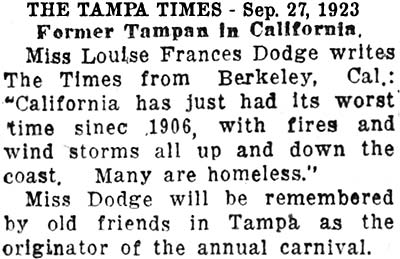 |
|
The
wildfires caused $10M damage in Berkeley.
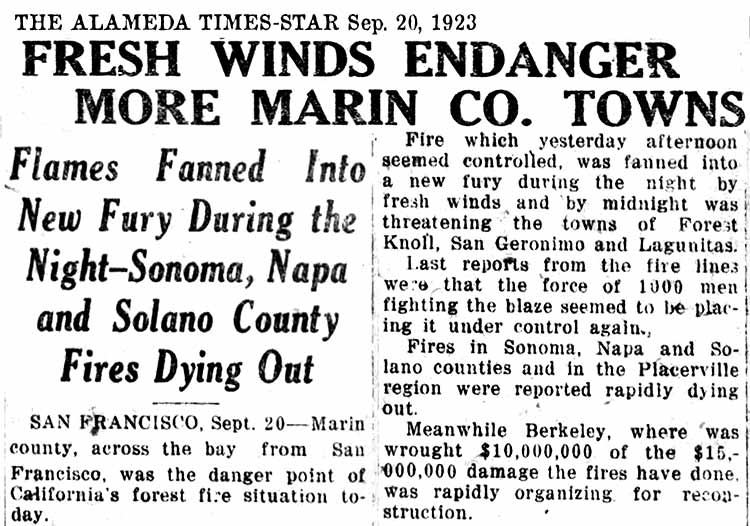 |
|
1924,
Jan. 11
THE OAKLAND TRIBUNE REPORTS OF THE
DEATH OF HELEN DODGE
Louise's mother died on Jan. 10, 1924 in
Berkeley. She was 84. She was
described as the wife of Rev. David A. Dodge and
mother of Louise Frances Dodge. Her
funeral was held at the First Presbyterian
church in Berkeley and she was buried in Adrian,
Michigan.
Her entry at Find a Grave.
1925,
May 1- THE DEATH OF DAVID A. DODGE |
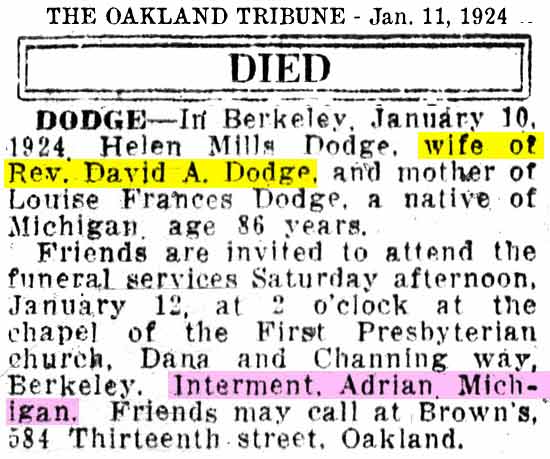 |
.jpg) Louise's
father died on Apr. 29, 1925 according to the
California State death index; he was 89.
After the death of his wife, he entered the Old
Soldier's Home in Yountville. He was
described as "Dr. David A. Dodge, retired
Presbyterian minister and Civil War veteran and
not regularly attached to any Berkeley church,
he many times preached from local pulpits.
He was a captain of Co. I, 18th Michigan
Infantry and member of Lookout Mountain Post 88, G.A.R. of Berkeley. G.A.R stands for
Grand Army of the Republic. Louise's
father died on Apr. 29, 1925 according to the
California State death index; he was 89.
After the death of his wife, he entered the Old
Soldier's Home in Yountville. He was
described as "Dr. David A. Dodge, retired
Presbyterian minister and Civil War veteran and
not regularly attached to any Berkeley church,
he many times preached from local pulpits.
He was a captain of Co. I, 18th Michigan
Infantry and member of Lookout Mountain Post 88, G.A.R. of Berkeley. G.A.R stands for
Grand Army of the Republic.
Excerpt from The Berkeley Daily
Planet - Feb. 12, 2008: Historical
Society Opens GAR Vet Group Records
Post 88 was established in Berkeley
on Nov. 14, 1885. After the war
between the states ended, the
veterans returned to their homes or
established new homes throughout the
U.S. Civil War veterans groups
were established all over the
country, including 102 of them in
California alone. The chapters or
“posts” held regular meetings,
collected dues, and went to
“encampments,” a sort of
campout-convention-get-together,
where they exchanged stories and
ideas. Quite a few were held in the
Bay Area. Each post selected a name
for their group in addition to the
number and region in which it was
located. Many of them chose the name
of a famous battlefield or important
location in the war. Berkeley chose
Lookout Mountain in honor of the
battle that took place there in
Tennessee. The Lookout Mountain Post
first met in the Odd Fellows Hall in
Berkeley and later in the Veterans
Memorial Building when it was
completed in 1928. Post 88 had 221
members, who served in many Northern
troop branches, including the U.S.
Navy, Calvary, Infantry,
Sharpshooters and Artillery. The
post existed for 54 years. Many of
the veterans were buried in Sunset
Cemetery in El Cerrito or Mountain
View Cemetery in Oakland.
|
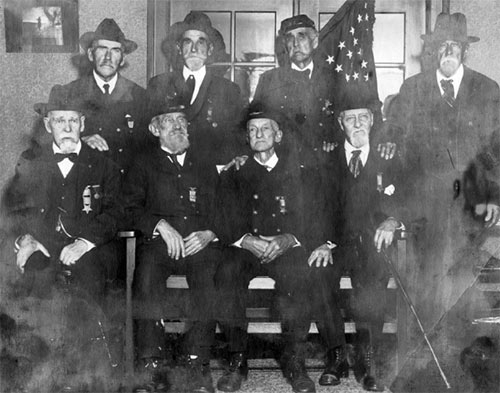 |
|
1923 photo of eight
remaining members of
Post 88. The four
standing members are,
left to right: M. R.
Mead, Nathaniel Michael
Miller, C. C. Reed, and
Joseph Honer. The four
seated members left to
right are: W. H. Wharff,
Erie Alanson May, George
Ober, and Waterman Van
Ess. |
SEE
Newsletter of the Berkeley
Historical Society "EXACTLY
OPPOSITE" Vol. 39, #2
"Berkeley's Civil War Legacy: GAR
Lookout Mountain Post 88 and Woman's
Relief Corpts No. 35" by Fred Etzel,
the source of the info below and
photo at right.
On
November 14, 1885, Berkeley’s Civil
War veterans established Lookout
Mountain Post 88. (The Battle of
Lookout Mountain was fought on
November 24, 1863 as part of the
General Grant’s successful
Chattanooga Campaign. An unknown
member of Post 88 may have fought in
that battle.) At the same time, the
wives of the members of Post 88
formed Woman’s Relief Corps No. 35.
Both Lookout Mountain Post 88 and
W.R.C. No. 35 met in the Veterans
Memorial Building located at 1931
Center Street.
info@berkhistory.org
|
Yountville is in the heart of Napa Valley,
nestled in Napa Valleiy's wine country.
See a history of the Soldiers Home from its
beginning in the 1880s.
See history at Wiki, now called the "Veterans
Home of California."
See photos at CALVET.
125 Year Anniversary of the Veterans Home, 2009. |
|
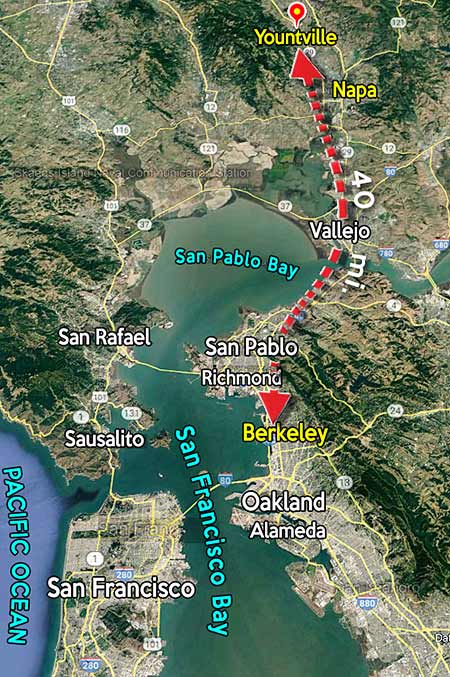
Photos below from California Historical
Landmarks in Napa County at
NoeHill Travels in California
.jpg)
California historic landmark 828 at SW corner of
California Drive and Hwy 29, Yountville.
.jpg) |
|
Old postcard photos below courtesy of Card Cow |
|
.jpg)
1886 |
.jpg) |
|
.jpg)
The Hospital
|
.jpg)
|
|
.jpg)
|
.jpg) |
|
|
|
|
LOUISE ON THE
1930 CENSUS,
IMOLA, NAPA COUNTY
In 1930
Louise was listed as a patient in the Napa State Hospital. Before
1922 this was called the "Napa State Insane Asylum." She is listed by her middle name,
Frances, instead of Louise, female, age 55, single, born
Iowa, father born New York, mother born Michigan. Except
for her first name swapped with middle name, all is correct. How
long had she been there? Answer is to come later below.
Imola was
originally an unincorporated area
in Napa County in the 1870s, located on the Southern
Pacific Railroad, 1.25 miles south of Napa. The area
was named for a town of the same name dating back to 1304 A.D.
in the province of Bologna, Italy, which maintained a large
insane asylum. The Imola post office opened in
1920, and closed in 1953. |
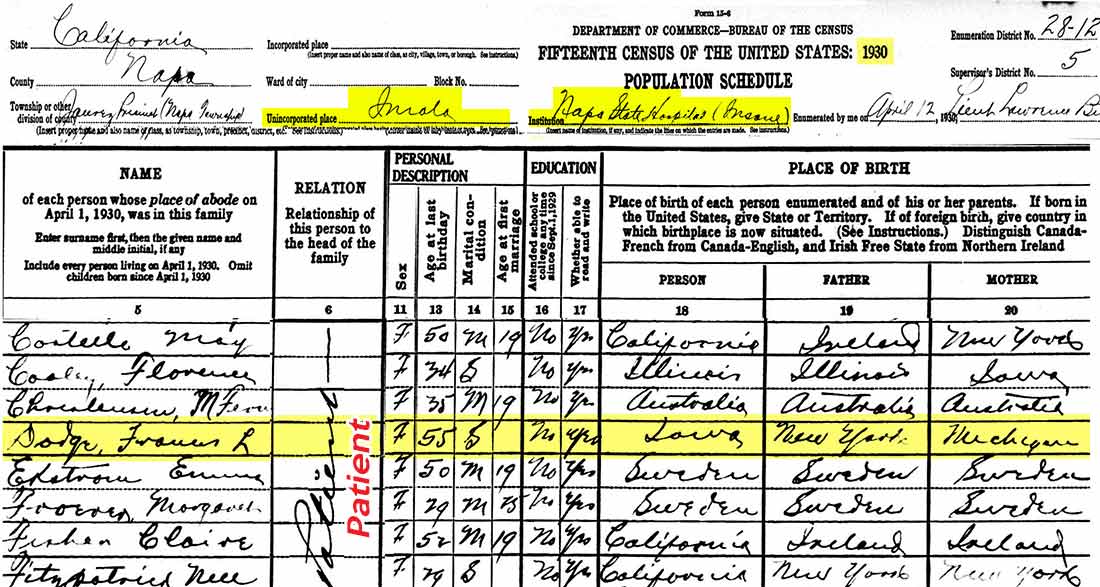
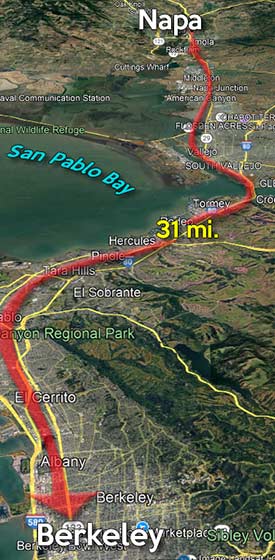
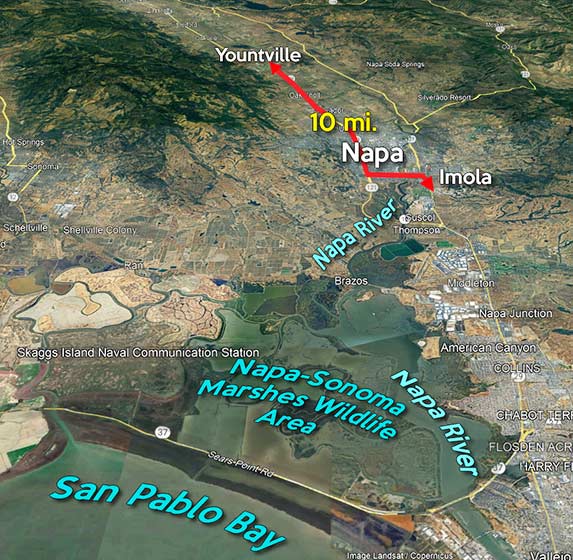
NAPA STATE HOSPITAL, IMOLA
Photos and info from Napa Valley Marketplace,
Kirkbride Buildings.com,
Napa Valley-from golden fields to purple harvest,
California Dept. of State Hospitals,
The Historical Marker Database, and
Wikipedia
KIRKBRIDE BUILDINGS
- Formerly
state-of-the-art mental healthcare facilities, Kirkbride
buildings have long been relics of an obsolete therapeutic
method known as Moral Treatment. In the latter half of
the 19th century, these massive structures were conceived as
ideal sanctuaries for the mentally ill and as an active
participant in their recovery. Careful attention was given to
every detail of their design to promote a healthy environment
and convey a sense of respectable decorum. Placed in secluded
areas within expansive grounds, many of these asylums
seemed almost palace-like from the outside. But growing
populations and insufficient funding led to unfortunate
conditions, spoiling their idealistic promise (to put it
mildly.)
Kirkbride buildings
are named after Dr. Thomas Story Kirkbride, a nineteenth-century
physician and asylum superintendent who authored a treatise on
hospital design. This treatise and Dr. Kirkbride's other work
had a far-reaching influence on the construction of American
insane asylums through much of the latter half of the nineteenth
century. Kirkbride buildings are most recognizably characterized
by their somewhat unique "bat wing" floor plan and their often
lavish Victorian-era architecture. Their design was an attempt
at creating a space to facilitate the return to sanity. The
buildings were conceived by Dr. Kirkbride and his contemporaries
as active participants in treating the mentally ill. |
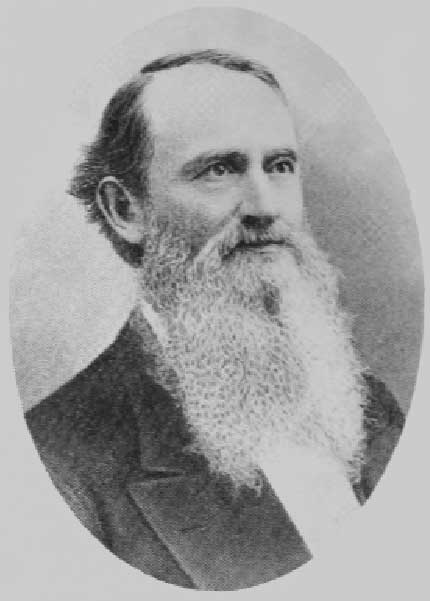 |
|
Dr. Edmund T. Wilkins
Superintendent from Mar. 1876 to Feb.
1891. |
The first hospital for the
mentally ill in California was the Stockton
Asylum for the Insane which opened its doors in 1851. It
was built to accommodate 80 patients but within 20 years
the institution became desperately overcrowded. During the
1869-70 term, the California State Legislature passed an act
enabling Governor Henry Huntley Haight to appoint Dr. E.T.
Wilkins as a commissioner to research existing asylums in the
United States and Europe to gather ideas and plans to build the
second state asylum. Dr. Wilkins made an exhaustive report
favoring the "moral treatment" of the mentally ill
and presented it the governor on Dec. 2, 1871.
After reviewing it, the state legislature approved
an act to build a second state hospital. In 1871, Dr. E.T. Wilkins, Dr. Benjamin
Shurtleff of Stockton, and Judge C.H. Swift of Sacramento were
appointed to select a site for the proposed asylum.
The trio
issued a report that recommended a site at Rancho Tulocay, owned
by Don Cayetano Juarez, due to its arable land and healthy water
supply, as well as its proximity to the railway and
Napa Embarcadero (wharf).
|
 |
|
Image courtesy of Wikipedia |
Rancho Tulucay was a 8,866-acre Mexican land
grant in present day Napa County, California
given in 1841 by Governor pro tem Manuel Jimeno
to ranchero Cayetano Juarez. The Tulucay
name originates with the names Tulkays and
Ulucas that were applied to the inhabitants of
Tuluka, a Patwin village in the area. The grant
was on the east side of the Napa River, between
Soscol Creek on the south, and Sarco Creek on
the north.
See source
Wikipedia for more.
In 1872, approximately 192
acres of land were purchased from Juarez for
$11,506. In 1872, Wright & Sanders of San Francisco
were awarded the contract for the asylum, a building
which was to be “constructed of either brick or
stone that would accommodate at least 500
patients—cost not to exceed $600,000.” Work
began for the erection of the 500-bed, four-story,
Gothic Hospital building. Ground was broken in Oct.
1872 and construction began on Feb. 11, 1873, the
cornerstone laid and the building was dedicated on
Dec. 24, 1874.
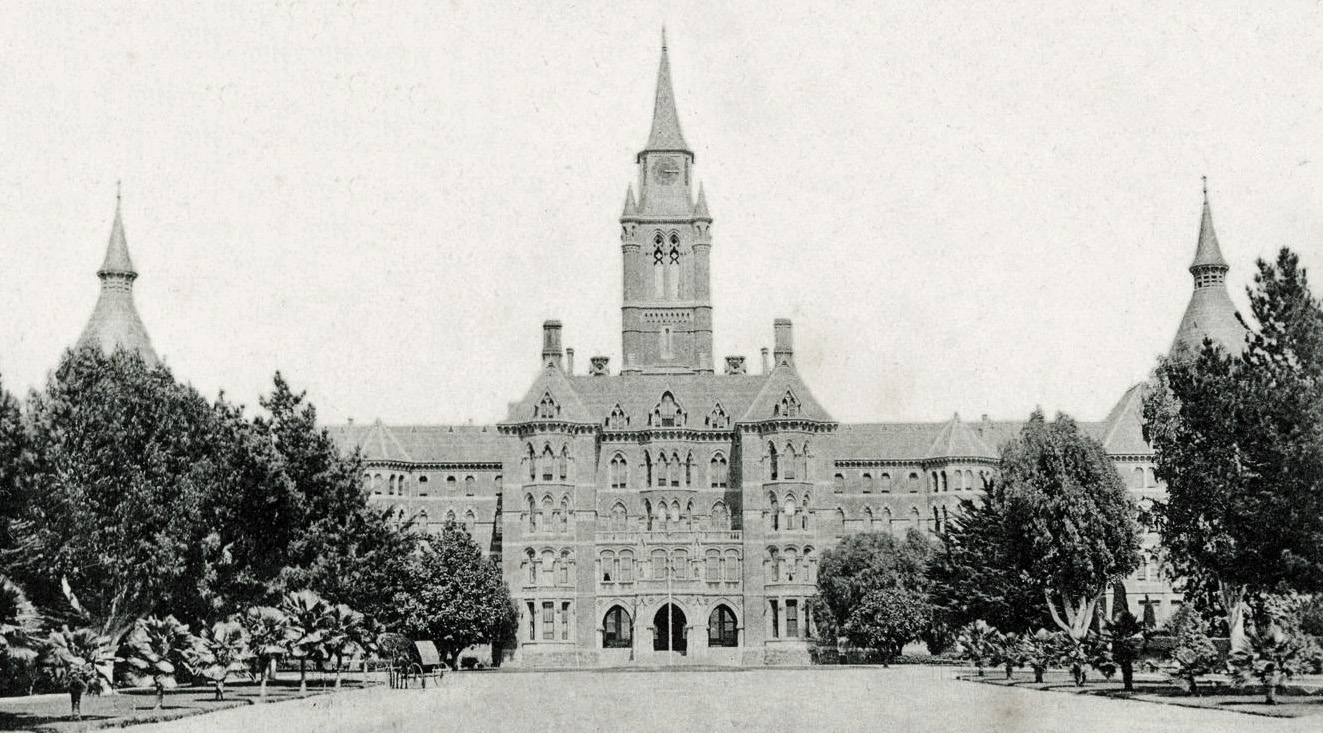
Front view of the main building
which was known as "The Castle."
Postcard photo courtesy of Napa Valley Register.com.
Building materials included Vermont slate, Colfax
marble, and millions of bricks manufactured on-site. The three
to five story building was composed of one main
“castle” and two identical wings. There were a total
of seven towers, four of which were used to store
water for the facility’s gravity-flow elevator
system, as well as fire protection. The building was
allegedly a mile in circumference. There was much
political controversy surrounding the cost of the
building. Democrats argued that the building was
needlessly extravagant and expensive, and
Republicans defended the cost as necessary to create
a healthy environment for the mentally ill. The
final cost of the building has been variously
recorded as anywhere between 1.25 and 1.75 million
dollars.
Originally named the Napa
State Insane Asylum, the
facility opened and admitted its first patients on
Monday November 15, 1875. The seven-towered domestic
Gothic structure was elaborate and ornate, and its
uniqueness made it one of Napa's early tourist
attractions. The hospital faced west with
wings extending on each side, allowing for plenty of
fresh air to flow throughout the facility.
During the 1906 San Francisco
earthquake, statues atop the roof and towers toppled
to pieces to the ground but the buildings remained
largely intact. There was even an underground cog railroad that was
used to carry meals and laundry to the hospital's
wings.
The Hospital was once self-sufficient, with
its own dairy and poultry ranches, vegetable
gardens, fruit orchards and other farming operations
that provided a large part of the food supply
consumed by the residents. Later, more land
was purchased bringing the total to 2,062
acres. This included a wharf on the Napa
River, a siding at the Southern Pacific Railroad
tracks, vegetable fields, a duck ranch, and the
Skyline Park ranch. Streams to the east were
dammed at an outlying ranch bounded by Coombsville and Green Valley roads
to provide the
hospital's main source of water. Cattle was
raised on the Napa State Hospital Farm just
northeast of Yountville which also provided beef for
the Veterans Home of California, and San Quentin.
The average stay for patients was about three
months to a year. A standard of moral treatment was
established from the earliest days of the hospital,
with occupational therapy programs and exercise
classes as part of the treatment. The
Napa Asylum treated patients for a variety of
ailments. Many of the early residents were admitted
due to alcoholism or homelessness. Women admitted at
the end of the 19th century were often diagnosed
with acute mania, melancholia, or paranoia.
By the early 1890s, the facility had over 1,300
patients which was more than double the original
capacity it was designed to house. In 1893, the
Mendocino State Hospital was opened and relieved
some of the overcrowding at the Napa hospital.
In 1922 the Department of Institutions was
established and viewpoints changed. The name
of the facility was changed to "Napa State Hospital"
and the term "insanity" became recognized as "mental
illness." The castle's main buildings became outdated and
were demolished in 1949.
This rear view of the hospital
shows laundry drying in the sun propped on
racks in the yard. An orchard can be seen in
the foreground.
Photo from Napa Valley Marketplace
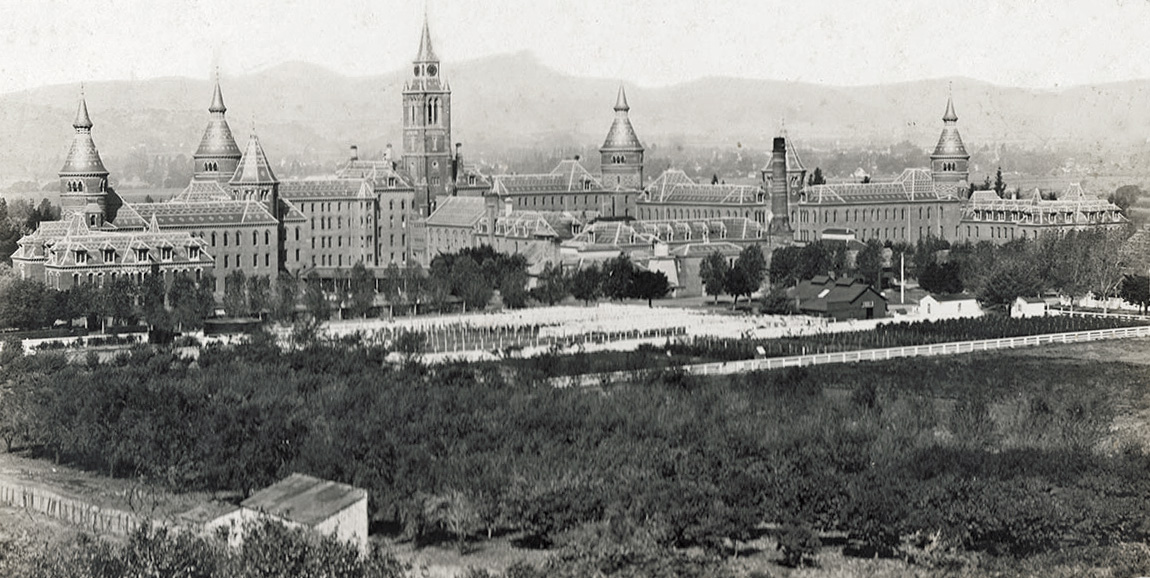
BURIALS:
A
two-acre piece of land on the eastern portion of the
campus behind the administration building was
designated as a cemetery for indigent patients from
about 1875 through 1923 and became the final resting
place for 4,368 patients' remains. These were
patients for which nobody claimed their remains,
hence the responsibility of burial fell on the State
of California. For research purposes, the original
name Napa State Asylum can be found on old death
certificates issued prior to 1924 which is when the
name was changed to Napa State Hospital. At
one time, the cemetery did have wooden crosses
marking each grave, but in the 1920s after the
burials stopped, the land became a pasture; by the
1940s a dairy farm was on it; and today, the site
has an unused barn and an outbuilding on it.
Since land for burial on the campus was limited, an
on-site crematorium was built at Napa State Hospital
in the mid-1920s and was in use until sometime in
the 1960s. In the 21st century, two old grave
markers from this era were found. In 1983 a single
marker was placed in remembrance of those buried on
the hospital's grounds. No bodies were ever
exhumed from Napa State Hospital grounds, but the
unclaimed cremated ashes of patients have been
transferred elsewhere: The ashes of 440 patients
were buried with numbered markers in the pauper's
section at St. Helena Cemetery; and at least 5,100
patients' ashes were buried in a mass grave on
October 28, 1968 at Napa Valley Memorial Park on
Napa-Vallejo Highway. Napa Valley Memorial Park has
in the past used the names of Inspiration Chapel and
Chapel of the Chimes. Twenty-eight patients were
buried in unmarked graves in the pauper's section at Tulocay Cemetery. Today, the few patients who do die
at the Napa State Hospital are transferred to their
county of residence for funeral arrangements to be
made by the family or an appointed representative.
The hospital has an annual memorial service in
remembrance of the patients who died that year as
well as the others of earlier years. |
|
Today, the location of the original hospital is home
to administrative offices and doctors' offices.
The patients' units are south of S. Oak Drive in
buildings designed and laid out like prisons. None of the
patients are there voluntarily, they are all sent
there by the State court system. |
|
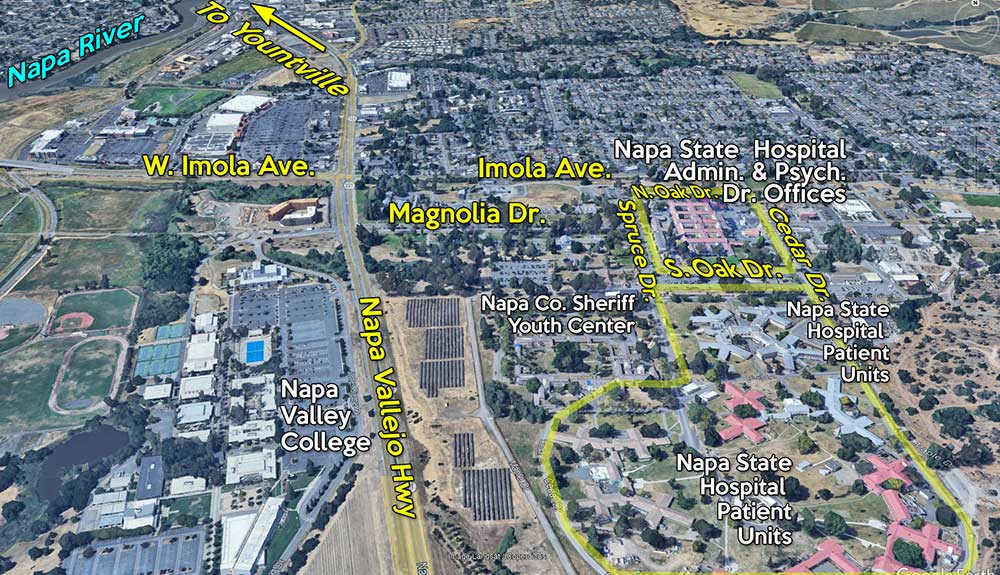 |
|
WHY WAS LOUISE HERE IN 1930?
We may never know the
answer to this and can only make some general
conclusions based on circumstances. Her
mother died in 1924 in Berkeley where they were
renting their home on Dwight Way. Her father entered
the veterans' care facility soon afterward and died
in there May 1925.
Except for the five
years she spent in colleges at Ann Arbor, MI and
Nashville, TN from 1895 to 1900, and the one to four
years at most that she spent in St. Louis in 1910,
she lived with her parents all her life, including
at Winter Haven while she worked for the Tampa
Tribune. Her parents' deaths may have had a
huge impact on her psychological well-being.
(But wait, there's more later.) There is no
evidence that she ever had a job after leaving Tampa
except for her 1910 census in St. Louis.
|
|
1932,
April 5 - This article says Louise was visiting in
Napa Valley and spoke "enthusiastically of the
beauty and prosperous appearance of the valley."
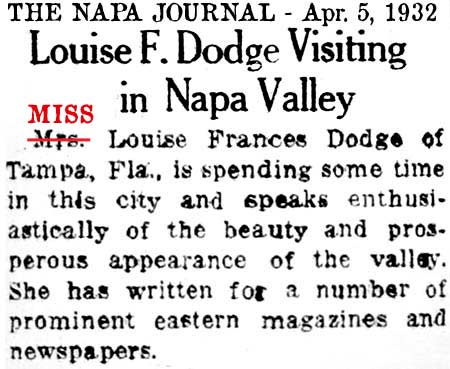
Was she
really just visiting?
How did
the Oakland Tribune know this? |
1932, July 31 - Louise
received a card from Pierre de Coubertin in response
to her message of well-wishes she sent him. Charles
Pierre de Frédy, Baron de Coubertin, was a French
educator and historian, co-founder of the
International Olympic Committee (IOC), and its
second president. He is known as the father of the
modern Olympic Games and was particularly active in
promoting the introduction of sport in French
schools.
Info and photo from
Wikipedia.
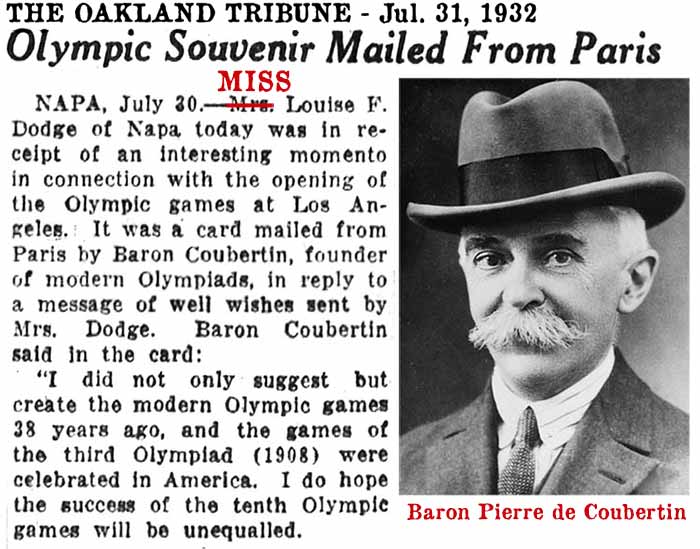 |
| |
The 10th Olympic games were held in Los Angeles. |

Photo courtesy of Olympics.com
DEATH OF LOUISE FRANCES DODGE
Louise died at the Napa State Hospital in Imola,
Napa County, California on June 19, 1933 at
11:30 a.m. Her cause of death was listed
as "Carcinoma of Breast," the date of onset was
"5 yrs." This would date back to around
June 1928.
The record also shows that her birth date (Mar.
22, 1875), birth place (Waterloo, Iowa), and
names of her parents (David A. Dodge and Helen
Mills) were obtained from her "commitment
papers, Napa State Hospital." Although no
commitment date is provided, it can be
calculated because the exact "Length of
residence" in this city or town, down to the
number of days, was provided. In this case, the
place was the hospital. Subtracting
9 yrs., 5 mos., and 3 days from her date of
death results in Jan. 16, 1924 as her commitment
date. This was six days after the death
of her mother in Berkeley at age 86 and
would explain the location of her father's death
at the "Old Soldiers' Home" in Yountville the
following year. His obituary stated he
entered the facility "with the death of his wife
about a year ago." Louise was unable to
take care of her father.
Her commitment date also indicates that the two
newspaper articles about her in 1932 were
written while she was confined.
Her doctor, Bert. M. Johnson, stated that he
attended Louise from Aug. 21, 1931 to Jun 19,
1933, so he was a doctor at the state hospital.
Louise was cremated three days later on June 22,
1933 at the hospital crematorium. It was
built in the 1920s due to lack of space in the
existing hospital cemetery and was in use until
the 1960s. As the history of this hospital
states earlier on this page, with nobody to
claim her ashes, they were probably buried at
the cemetery and then transferred with those of
440 patients' ashes to a mass grave at Napa
Valley Memorial Park in 1968.
See her death certificate.
|
THE FRIDAY MORNING MUSICALE CELEBRATES ITS FIFTY YEAR
ANNIVERSARY - 1952
|
FALSE CLAIMS
ABOUT THE DODGES
At the last of
five events of the FMM anniversary celebrations, which
spanned from Oct. 5, 1952 to May 10, 1953, a report about
Louise Dodge was read to those in attendance.
This "mini-bio" about Louise was written by one of the
club's charter members, Mrs. Mary Spencer Caldwell, but read
by someone else due to her "impaired eyesight." Mrs.
Caldwell was 80 at this time, so she would have been around 30 when
the club was founded and 32 or 33 when the Dodges left Tampa.
On May 17,
1953, the Tampa Tribune published a brief one-paragraph article
about the last anniversary event, making no mention of the
report.
In the May 31,
1953 Tribune, D. B. McKay covered the event in more detail
in his weekly column, "Pioneer Florida." It is here where he
revealed what he claims to be the content of the report.
In bold all-caps, it begins, "IT WAS RECITED..."
It praised
Louise for her accomplishments in Tampa. There
are a some false statements made regarding Louise's parents.
The second
paragraph, bolded and in all-caps, makes the claim that
Louise had a cousin who was a "fabulously wealthy New York
philanthropist" who bought Mr. & Mrs. Dodge a home in San
Francisco in "early 1906" and so Louise decided to move there
with them.
It goes on to describe the events of the earthquake; that it
destroyed their home and caused Louise to be separated from
her parents, and the tremendous psychological impact it had
on Louise. Basically saying that the disaster erased her mind, and only her
name on her watch led rescuers to her parents, and she never
recovered, spending the rest of her life in a nursing home.
It ends stating that her parents died "shortly after the
disaster."
If you've read
these two pages on the life of Louise Dodge, you already
know that much of what McKay reports is wrong. McKay
was 85 at the time. It remains to be seen if all of his
story was completely from Mrs. Caldwell's report.
At the end of
this feature, TampaPix addresses all the false claims made
in McKay's article, and questions the very idea that such a
depressing, tragic (and mostly false) story as reported by
McKay would have been read at the celebration. |
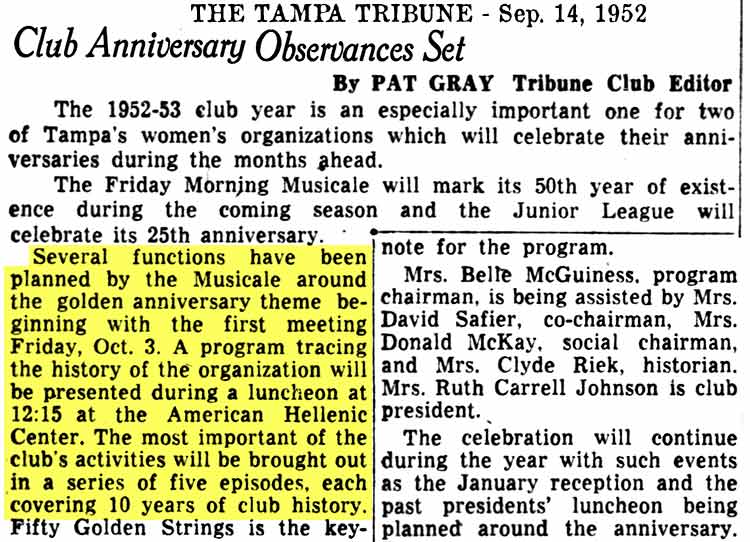
1952, Sep.
14
At right:
In 1952 the Friday Morning Musical planned five
meetings to celebrate its fifty year anniversary. The first
event one
was to be held on Oct. 3, 1952, at the American Hellenic Center.
|
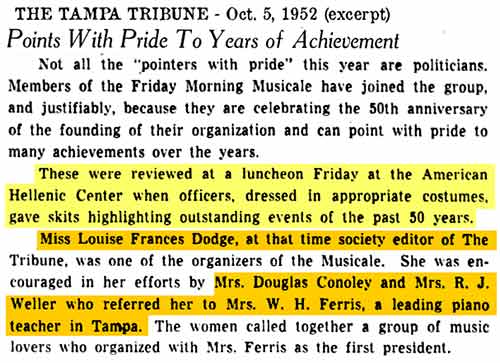 |
1952, Oct. 5
THE FIRST FIFTY YEAR ANNIVERSARY LUNCHEON
On Oct. 5,
1952, the Tribune published a full page article about what
transpired at this first event. Officers of the club
"dressed in appropriate costumes" and presented skits
highlighting the club's past fifty years.
They credited
Mrs. Douglas Conoley and Mrs. R.J. Weller for referring
Louise Dodge to Mrs. Ferris, "a leading piano teacher in Tampa."
Charter members present (members of the club
when it was first organized)
included Mrs. Annie Macfarlane
McPherson, who was a daughter of
Hugh Macfarlane, now remembered as
"the father of West Tampa,"
responsible for the initial founding
and growth of West Tampa as a city.
|
|
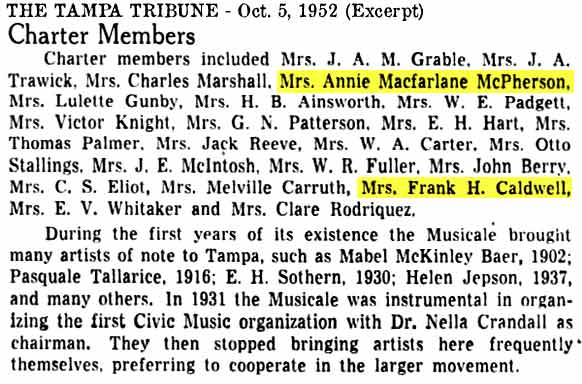
Read the
full article only, without photos,
from which the two excerpts at above
were taken, here at TampaPix.
As well as the above sections, it
covers the club's operatic work,
orchestras, school music work, and
past presidents. |
Annie Macfarlane was an very
talented vocalist and musician in
her youth, giving many local
performances.
Mrs. Frank H. Caldwell was Mary E.
Spencer Caldwell, also a charter
member. More about her below.
Later revealed in an article by D.B.
McKay, Mrs. Caldwell composed a short
biography of Louise Frances Dodge
which was read at this meeting.
TampaPix has found quite a few errors in
this bio, the sources of which have
already been presented here which
disprove some of the statements made
in Mrs. Caldwell's report. She
was probably relying on false
memories and assumptions to fill in
gaps. D.B.
McKay would write an article about
this presentation in his May 31,
1953 page "Pioneer Florida."
He may have even added his own
thoughts. Both would have been
trying to recall what happened
almost fifty years earlier.
This article by D.B. McKay is
presented further below.
|
|
You can read more about the
anniversary celebrations and see photos from this Oct. 5,
1952 full page Tribune article, including a portrait of
Mrs. Ferris,
HERE at TampaPix's
feature about Mrs. Ferris.
Don't miss it, there's lots of history on the pioneer Ferris
family of Tampa! |
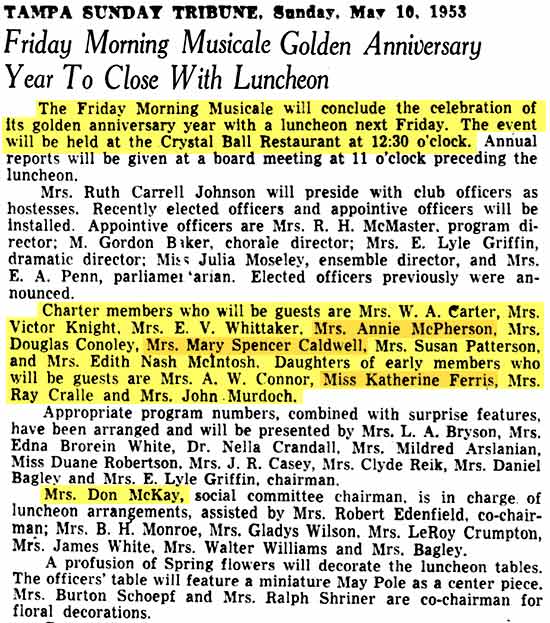
1953, May 10
FINAL ANNIVERSARY EVENT ANNOUNCED
The final FMM
anniversary event was to be held at the Crystal Ball
restaurant on May 15, 1953.
Miss Katherine
Ferris, one of the charter members mentioned here, was the
daughter and only child of the club's first president, Mrs.
W. H. Ferris.
Mrs. Mary
Spencer Caldwell was born in Fla. in 1873, she was the
widow of Dr. Frank H. Caldwell who died on Jan. 20, 1906 in
Tampa. They married on July 12, 1904 in Tampa, he was
47, she was 31. After his death she lived in Tampa with her
brother, Laurence Spencer and his family. Mary died in
Tampa at age 83 on Apr. 20, 1956.
"Appropriate
program numbers, combined with surprise features" had been
arranged for the event.
Mrs. Don McKay
was D.B. McKay's wife.
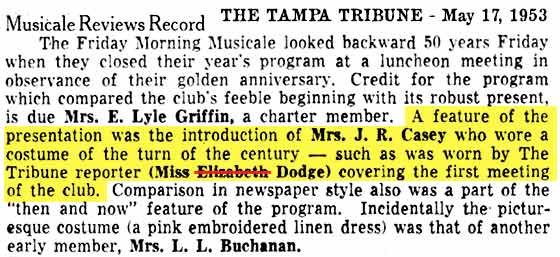
1953, May 17
THE TRIBUNE REPORTS ON THE FINAL ANNIVERSARY EVENT
The
Tribune's coverage of this final event was very brief. One
of the features of this event was Mrs. J. R. Casey who wore
a turn of the century costume in a skit portraying the
Tribune reporter Miss Elizabeth [sic] Dodge covering
the first meeting of the club.
1953, May 31 -
PIONEER FLORIDA BY D.B. MCKAY REPORTS ON THE FINAL EVENT
After his
time as mayor of Tampa and owner/editor of the Tampa
Times, D.B. McKay wrote a history column titled "Pioneer
Florida" for the Tribune, which was later compiled into a
3-volume book series. McKay was also editor of Karl Grismer's history of Tampa in 1950, so Grismer's
book contains much of McKay's input. McKay's feature usually filled a whole page
and covered three to five topics or so. Readers would
write the Tribune in response to McKay's feature and offer
more related stories and sometimes disagreement, which would often
be presented in the next feature.
In
the May 31, 1953 Pioneer Florida article below, McKay discusses the Friday Morning Musicale's
final luncheon which celebrated
its fifty year anniversary.
He says the club recognized that chief recognition for its
creation was due
to Louise Dodge and Mrs. Ferris, and goes on to mention other
early members. He describes
events at the most recent anniversary meeting which was held at the Crystal
Ball on May 15, 1953.
He says a paper was
read at the luncheon that was prepared by
Mrs. Mary Spencer Caldwell, an original member of the FMM, but
was read by another member due
to her impaired vision. (Mrs. Caldwell was 80 at the
time.)
McKay begins Mrs. Caldwell's report with "IT WAS RECITED"
but it's not known if McKay's story was copied from Mrs.
Caldwell's report or if it could be from his notes, or if
any of it was his own input. The first section seen
below is quite accurate according to what has been presented
in this TampaPix feature, with evidence to support it.
EXCEPT FOR:
-
Louise was
hired by the Tribune in July 1901, not 1902.
-
Her father
was NOT "of Boston" or anywhere near it.
This is a false memory or an assumption.
Mr. Dodge was
born in Rochester, NY, in 1837. His life has already
been presented in detail in this feature
about Louise Dodge. He wasn't born in
Boston, nor did he ever live there.
PART 1 OF 3 BELOW. |
|
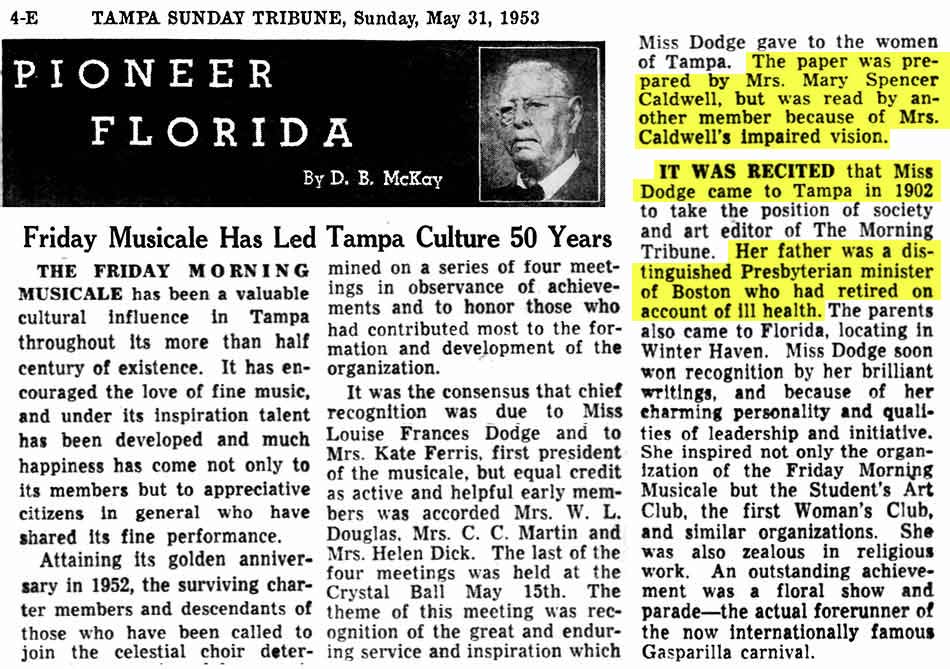
Mr. Dodge is not mentioned by
name; it was probably due to having been forgotten. Mr.
Dodge is never mentioned as having ill health in the news.
He did lots of traveling between Winter Haven and Tampa, and
attended several Presbyterian conferences in the state.
When the Dodges left Florida, they toured the country for about
four months on their way to California. He did file for a
Civil War pension in 1893 when the Dodges lived in Michigan. |
The next paragraph was published in bolded text.
Whether this was in Mrs. Caldwell's report or it was added by
McKay it is not known.
You can see the article and photos at the
feature about Mrs. Ferris here at Tampapix.
McKay was born in 1868, and would then have
been 85 when he wrote this article.
The founding club president, Mrs. W. H. Ferris,
remained president until just before her death in 1924--twenty-two
years..
|
PART 2 OF 3 BELOW |
|
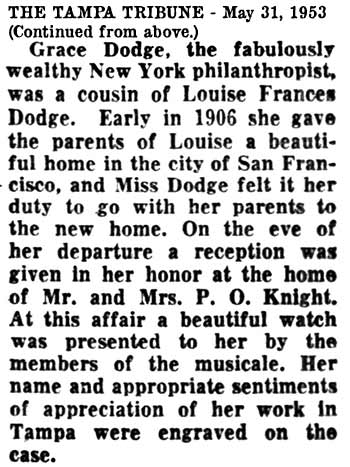 |
ABOUT THAT FABULOUSLY WEALTHY COUSIN -
COMPARING LOUISE DODGE'S ANCESTRY TO GRACE DODGE'S
ANCESTRY
McKay claims, or is reporting on what Mrs.
Caldwell's report stated, that Grace Dodge, "fabulously
wealthy New York philanthropist," was a cousin
of Louise, and that she gave Louise's parents a
beautiful home" in San Francisco early in
1906." and "Miss Dodge felt it her
duty to go with her parents to the new home."
So
a necessary inference is that
the San Francisco
home was first bought for Louise's parents, and so Louise
decided to move there with them because it was
her duty.
Contrary evidence:
The news of the Dodges' decision to move to
California was made known in the Tribune on Mar. 5,
1905, so the decision to move there would
have been
made even sooner. This was at around a full year before Grace Dodge
is said to have bought them a home in SF.
Was Mrs. Caldwell or McKay only incorrect about the year?
Or are these false memories?
Louise left Tampa by train in April 1905 for
Jacksonville, then planned stops in Atlanta, S.
and N. Carolina, Washington DC, NYC, where her
parents would join her, and then they were to go on to New England
states.
|
|
But
instead, M&M Dodge left Tampa on May 25 to meet
Louise in WASHINGTON D.C. It isn't known
if they visited NYC or New England states.
They made their way west, sightseeing the
country on the way. Louise wrote the
Tribune from
Portland, Oregon on Aug. 1, 1905 and they were in San Francisco in
EARLY AUGUST 1905 as stated in her Nov. 12, 1905
letter from San Francisco published in the Tampa
Tribune. So they were in SF at least five
months before Grace Dodge reportedly bought them
a home there.
Were
Grace and Louise Dodge really cousins or was this just rumor or
gossip, or a legend that started and evolved
over the past 50 years? Was it based on an
assumption that they must be related due to the
well-known David Low Dodge in the wealthy NY
family? Could it
have been an idea that sprouted and grew in Mrs.
Caldwell's or McKay's as false memories over the
years, becoming convincingly real at this point?
(False memories discussed at the end of this
page.)
Below is a comparison of Grace Dodge's ancestry
to Louise's ancestry. If they were 1st
cousins, they would share the same grandparents.
If they were 2nd cousins, they would share the
same great-grandparents. If they were 3rd
cousins, they would share the same
great-great-grandparents. As you can see,
they don't share any ancestors at all.
They don't even share the same gr-gr-gr-grandparents, though not shown here.
A quick search finds
a Britannica dot
com entry: Grace Hoadley Dodge (born May 21,
1856, New York, N.Y., U.S.—died Dec. 27,
1914, New York City) was an American
philanthropist who helped form organizations
for the welfare of working women in the
United States. Dodge was of a wealthy family
long active in philanthropic work. She
was a
great-granddaughter of David Law Dodge, New
York merchant and peace activist, and
granddaughter of William Earl Dodge, metals
business executive and philanthropist."
By
1906, Grace Dodge was involved with the YWCA and
was appointed as chairman of the new joint
committee to unite the American YWCA and the
International Board of the YWCA, which were
separate entities at the time. The article
concerning this says she was not a member of
either organization.
The
obituary of Louise's paternal grandfather, David
Dodge II (DDII), doesn't mention any ties to this
well-known, influential and wealthy Dodge
family. DDII was born in Herkimer Co., NY in
1797 where his father, David Dodge I had just
moved. Within a year after DDII was born they moved back to
Mass. and to Oxford, Mass., in 1819. DDII
married in Oxford, MA in 1826 to Ruth Freeman, a
descendant of Br. Gen. Ebenezer Learned of the
Revolutionary War.
DDII and Ruth soon
moved to Rochester, NY (1826) where Louise's father,
David Archiblad Dodge (1837), and at least 6 other children were
born. DDII's obit said he was a
stone mason and master builder, constructing 3
churches in Rochester and excavating below the
falls of the Genesee River. That endeavor
was a failure as the investors who were funding
the project
went bankrupt. The Dodges moved to Ionia Co. MI
in 1843 where David II became a farmer and died
in 1886.
It
is a certain fact that Grace & Louise were NOT
first or second cousins. It
is HIGHLY DOUBTFUL that Grace was aware of
anyone who would have been her 3rd cousin, which
by definition meant they had the same
great-great grandparents. To think
that a 4th generation descendant would have kept
in touch with, or even been aware of Louise's
father, who had left the state of Michigan after
marrying in 1865 and moved to
Iowa where Louise was born, moved back to
Michigan, then Florida in 1900, then California
in 1905, is an unlikely scenario.
Especially for Grace Dodge, a very busy woman.
Her charities were organizations, and though she
theoretically have privately helped Louise's family,
it's virtually impossible that she knew of them.
In four generations there could be hundreds of
living descendants. These were times of letter-writing.
Grace having a birth year of 1856 would put
her at about 20 years older than Louise, who
was born 1875 in Waterloo, Iowa where her
father was a lawyer at the time.
TampaPix has found good evidence that Louise
may have been related to Clara Barton, going way back
to Ebenezer Learned in Oxford, Mass. in colonial times.
|
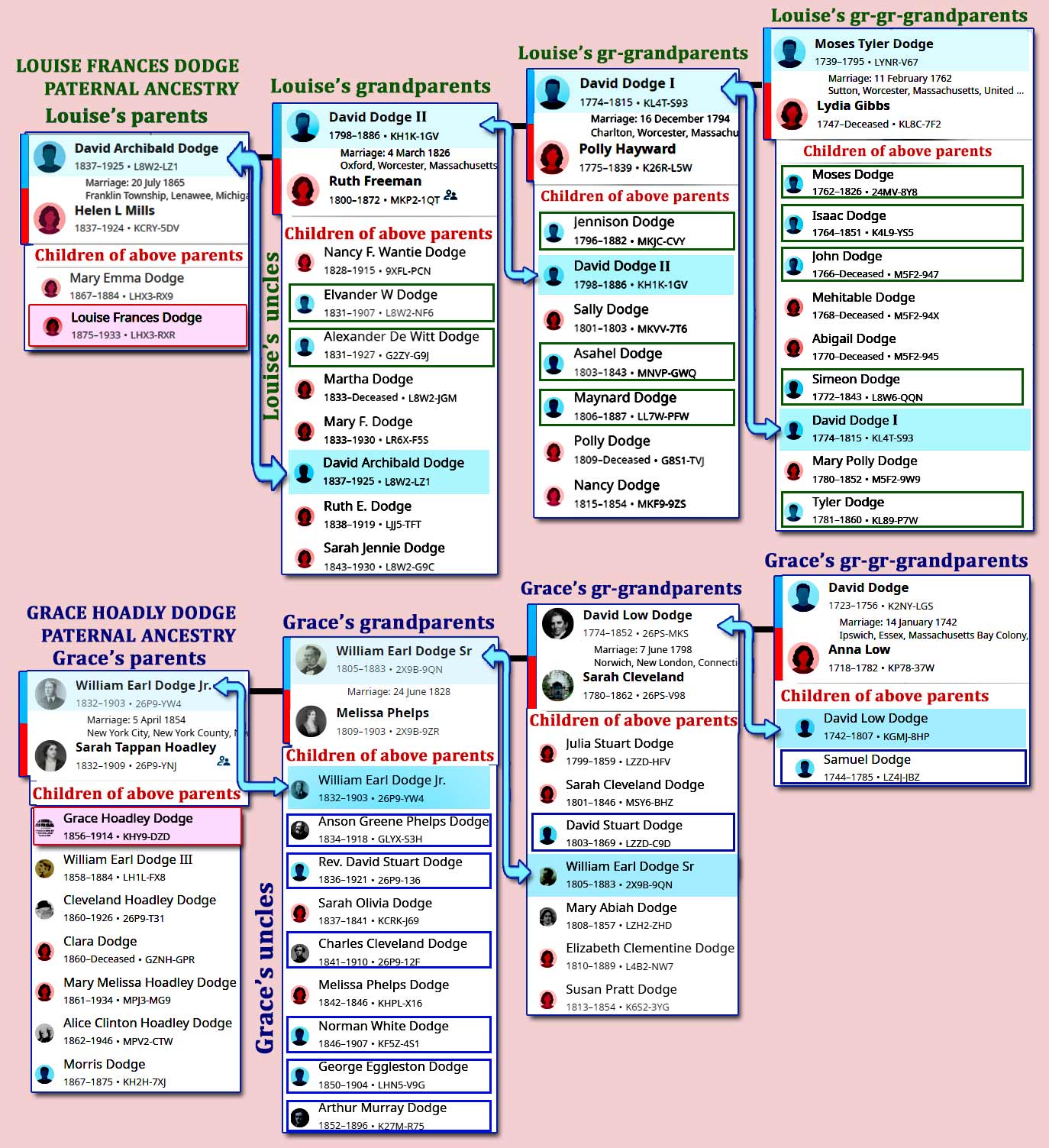 |
Known Dodge first cousins of Louise who
whose death year is unknown or after
1875--children of brothers and sisters
of her father, being grandchildren of David
Dodge I and Ruth Freeman.
Children of Nancie F. Wantie Dodge &
William Jennings
Charles W. Jennings, b. 1847
Frank C. Jennings, b. 1849
David W. Jennings, b. 1850 d. 1910 m.
Fidelia Lousa Rice 1877, Ionia MI.
Mary Frances Jennings, b. 1852 d.1892 m.
Judson C. Bentleyi 1871 Ionia, MI
Minessa Arabella Jennings, b. 1855 d.
1925 m Walter Harshorn Merriiam 1877
Ionia, MI
Nancy E. Jennings, b. 1861 d.1948 m.
Fred T. Mason 1888 Ionia, MI
Children of Elvander W. Dodge &
Clarissa S. Walker
Harriet Dodge b. 1856
Cordette Dodge b. 1858
David Freeman Dodge b. 1860 m. Margaret
Burke 1900 NY
Children of Alexander DeWitt Dodge &
Louise Clark Lovell
William Dodge b. 1858 m. Julia E.
Harriet Trumbull
Helen Lowell Dodge b. 1862 d.1943 m.
Frank G. Kneeland 1882 Ionia, MI
Edward Larned Dodge b. 1864 d. 1923
m.Nellie Sheppard 1890 Ionia, MI
Cyrus L Dodge b. 1865 d. 1877
Children of Martha Dodge & Orson S.
Kendrick
Frances Kendrick b. 1853 d. 1942 m.
George Bannerman
Children of Mary F. Dodge & Walter J.
Tabor
Jennie A. Tabor b. 1859 d. 1923 m Silas
M. Gleason 1881 in Ionia, MI
Children of Ruth E. Dodge & Ira
Winegar
Jane Augusta Dodge b. 1865 d. 1880
Ira Weston Winegar b. 1868
Children of Sarah Jennie Dodge & Dr.
Freeborn F. Hoyt
Benjamin Floyd Hoyt b. 1871 d 1944 m.
Eva May Eggleston 1900 Los Angeles, CA
|
| |
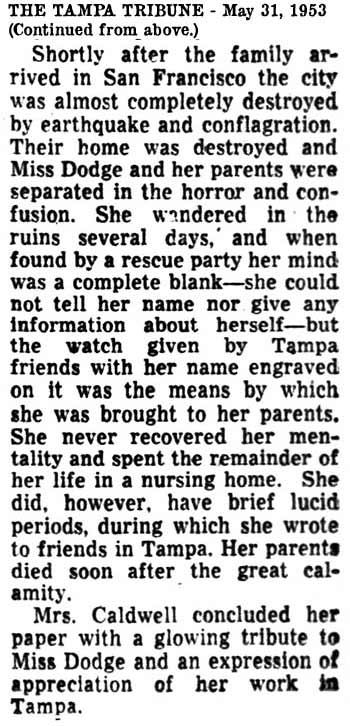 |
CONCLUSION OF D. B. McKAY'S ARTICLE
Of primary concern here is why would
Mrs. Caldwell write such a tragic,
depressing story to be read at such a
joyous celebration as the 50th
anniversary of the FMM? And
especially at the last event of the
celebration so that it would be the last
thing weighing on everyone's minds.
Or was this something McKay added to the
story for his column?
Was Mrs. Caldwell writing from memories?
Was McKay writing from memories? Forty
year old memories for 80 year olds can
be vastly evolved from the actual
events, especially if one doesn't think
of them very often. Time has a way
of completely changing one's perception
of past events. We are all too
proud if we think that our memories are
rock-solid and unchanged by time.
"Their home was destroyed..."
Louise's letter to the
Tribune from Camp Meeker ten days after
the earthquake specifically mentions
what they lost--their trunks and valuables. They lived in an apartment; she
mentioned this more than once, Louise
never mentions living in their own home.
She never mentioned any residence except
for their apartment. Would
Louise have been too shy or humble to
mention a rich philanthropist cousin?
Would she have been embarrassed to admit
it or considered it boasting? Was
it humiliating to her that their parents
didn't buy their own home?
TampaPix doesn't think so. Not even
in her letter of November 1905 did she
say anything about a beautiful new home.
Had they owned a home, it's highly
doubtful that Louise would not have even
briefly mentioned losing it or it suffering
some damage. Could she have wanted
to keep her letter positive and not
bring up personal thoughts, to not worry
readers or cause them to pity her?
Possibly, but she probably would have found a way
to mention it and keep it positive.
After all, writing was her expertise.
|
|
"Miss Dodge and her parents were
separated in the horror and confusion..."
Not so. McKay's article implies that
they were together when the earthquake
started and it caused them to be
separated. We already know that
Louise's parents had left SF for Camp
Meeker before the earthquake.
The earthquake did not cause them to be
separated.
"She wandered in the ruins several
days, and when found by a rescue party
her mind was a complete blank..."
We already know that she was taken out
of the city by friends the morning of
the earthquake, and watched from nearby
suburbs for four days until the fires were out.
This was written in her lengthy letter
to the Tribune from Camp Meeker just 10
days after the disaster.
"...she could not tell her name nor
give any information about herself..."
In her letter sent to the Tribune ten
days after the earthquake she described
vivid details about the event, and where
her parents were when the earthquake
hit.
"The watch
given by Tampa friends with her named
engraved on it..." In 1904
when this watch was presented to her at
the farewell reception, the Tribune
wrote "the watch bears in engraved letters the names of the
clubs..." McKay
now mentions that her name and
"appropriate sentiments of
appreciation..." were on it. This
sounds like a generic statement that
someone would make because it's what one
typically expects to be engraved on the
back of a watch. How big was
this watch to have the lengthy names of
at least three clubs, sentiments (even
if just "Good Luck!"), and Louise's name
on it (which surely would have included
her middle name? He makes no
mention of the names of the clubs which
was the only inscription described in
1904.
We can't rule out that Louise was
keeping the truth secret and didn't
reveal what really happened to her.
But the fact that she wrote an
incredible description of the disaster
just ten days after it is evidence that
she was quite stable and not
psychologically devastated by the
earthquake. In fact, her comments
about survivors going about their ways in a
positive state of mind is corroborated
by many newspaper articles describing
the disaster.
As for the rest of
McKay's article, we can
definitely discredit what he wrote,
or what Mrs. Caldwell reported, or both,
and when part of a statement can be
discredited, it all becomes suspect.
"She never recovered her mentality
and spent the remainder of her life in a
nursing home." This
feature has already shown irrefutable
evidence that after the earthquake, the
Dodges lived in San Francisco until just
before 1910, when they moved to
Berkeley. There was evidence that
Louise wasn't living in Berkeley on the
1910 Census and instead lived in St.
Louis for a time, working as a reporter.
There is proof that Louise attended the
University of California at Berkeley
starting in Sept. 1913 and participated
in school activities in 1914 and 1915.
She entertained Berkeley students among
her guests at her birthday dinner party
in 1917, which was published in the
Berkeley Daily Gazette and repeated in
the Tampa Tribune. These weren't stories originating in letters to
friends in Tampa. These were news
articles that neither Mrs. Caldwell or
McKay were aware of or didn't remember.
She served as a
precinct polling place judge at the
Alameda County polls in 1918, 1919,
three times in 1920, and in 1921,
located down the street from where she
lived in Berkeley. These were
articles published in the Oakland
newspapers under legal notices which
named elections officers appointed to
serve in Alameda County.
"She did have brief, lucid
periods, during which she wrote to
friends in Tampa." How
would anyone know that these letters
were written during the "brief, lucid
periods?" Not receiving letters
during her mentally unstable periods? It's not
possible to conclude what's going on
during periods of lack of communication.
It was an
assumption that she lived the rest of
her life after the earthquake in a
nursing home that led to assuming that
she never regained her
mental stability after the "amnesia"
caused by the earthquake. So therefore
lucid letters received had to be, in
their minds, from
brief lucid periods when she would write.
"Her parents died soon after the great
calamity."
This is the ultimate proof that the
report is based on assumptions with no
knowledge or accurate memory of what
really happened--memories that have been
completely changed over time, forgotten
facts, exaggerated and dramatized over
the years, or just plain fabricated by
Mrs. Caldwell or McKay. The
statement that "she spent the
remainder of her life in a nursing home"
is probably a confused memory of where her
father died.
Louise's parents died 18 and 19 years
after the earthquake, in 1924 and 1925.
This isn't "soon after the great
calamity."
|
TampaPix believes that Mrs. Caldwell may
have been in touch with Louise or have
known someone who had been in touch many
years earlier when the Dodges first
moved to SF. They remembered that
the Dodges were in SF for the
earthquake. Years later, they may have heard
about the deaths of Mrs. and Mr. Dodge,
They may have heard that Louise had been
committed to a state mental hospital.
Over the span of 25 to 45 years, all
these thoughts evolved, blended
together, and were influenced by other
events, changed and continued to evolve
as false memories. The death of
Mr. Dodge in a nursing home combined
with Louise's confinement at the Napa
State Hospital produced a combined
memory, one that included the brief
mention of her watch in the 1906
article.
As evidenced by other false statements
about Louise's family, it all fits in
with how false memories are created.
Different events over long periods of
time, undocumented by the storyteller,
with nothing unchanging to refer back
to, blended together over time with the
subconscious altering of the facts as
one's brain tries to make the puzzle
pieces fit together. Along the
way, other events, other memories,
things other people say, influence the
memory. All this taking place
without Mrs. Caldwell knowing, she
writes these false memories down on
paper as if it happened yesterday.
Events are out of
order from reality, such has Louise's
parents died shortly after the
earthquake. Louise had a rich
cousin who bought her parents a house,
but turns out they had actually moved
there several months before.
Whether or not Louise's name was on the
back of the watch cannot be proven, but
the brief mention by Louise as being one
valuable she saved from the disaster
could be enough for any club member to
form into a false memory over the years.
Mrs. Caldwell's story could have been a
combination of memories, true or false,
gathered from
various other members of the
club or friends.
Any one of the contributors may have
wondered once or twice over the years if
this Grace Dodge philanthropist
they had heard of was related to Louise.
Seeds that could have sprouted and became one
big tree.
| From
Can You Trust Your Memories? and
False Memories
Although memories seem to be a solid,
straightforward sum of who people are,
an avalanche of research reveals that
our memories aren’t static imprints of
past events but rather reconstructions
of our experiences that are much more
complex, highly subject to change, and
often simply unreliable. What we
remember is continually reshaped by new
information and a variety of factors
that influence what we recall and how we
recall it Memories of past events
can be reconstructed as people age or as
their worldview changes.
Media and external events can
seep into and reconstruct our
memories. News reports, social
media, and even casual
conversations influence our
recollections and blur the line
between our experience and
secondhand information. For
example, after 911, the constant
exposure to footage of the
second plane hitting the World
Trade Center led many to form
detailed memories of having seen
it live, even if they didn’t.
This phenomenon, known as
flashbulb memories, shows how
repetitive media can distort our
memories.
If you see a photo of a
person you have never met, for
example, and mutual friends have
shared descriptive details on
time they've spent with the
person, you may later start to
believe that you have in fact
met the individual.
People regularly recall
childhood events falsely, and
through effective suggestions
and other methods, it's been
proven that they can even create
new false memories. A person’s
malleable memories often involve
the mundane, but they can often
be far more consequential, such
as unreliable eyewitness
recollections of a crime. Human
memory is pliable and easy to
manipulate. A distorted memory
or the introduction of later,
false information can affect how
we recall events we experienced
firsthand.
A person's existing knowledge
can impede and obstruct their
own memory, leading to a newly
formed, cobbled-together
recollection that does not
accurately reflect reality.
Also, under certain
circumstances, a person can be
given false information and be
convinced to believe that an
event that never occurred
actually did. When this
happens with lots of people,
it's called the "Mandela
Effect."
Imagination can be a culprit
that distorts our memories.
Presented with incomplete
information, the brain seeks to
fill in the gaps with assumed or
imagined details, blending into
past events what we wish or
imagine could have happened.
Emotions profoundly impact how
we remember the past.
Emotionally charged events are
more vividly recalled because
stress hormones enhance memory
formation, and negative emotions
tend to overpower and supplant
positive ones. This distorts our
memories, making deeply
emotional aspects of an event
stand out while more positive
aspects fade away. For instance,
a family vacation may be
remembered mostly for a meltdown
with teenagers rather than for
the relaxing moments at the
beach.
Social influences also
transform our memories. When
engaging with friends and
colleagues, we often craft
shared narratives to bond or fit
in. This can result in the
memories of others overriding
our own. For example, if a
friend mistakenly recalls that
you both attended a book fair
together years ago, you might
start to believe you were there
and adopt their memories as your
own, even if you actually
weren't there.
This shape-shifting nature of
memories is like the classic
game: A whispered story morphs
and mutates with each retelling,
as players add their own
selective hearing,
interpretations, and biases.
Ultimately, the final story
little resembles the original.
Imagine the drastic effects this
game would have if it was drawn
out over a period of forty years
instead of four minutes.
Similarly, when you repeatedly
mull over an old memory, it can
become difficult to distinguish
the original details from newly
introduced ones created to fill
in the gaps without your
conscious thought. Over a
lifetime of brief flashes of the
event, with subtle changes, the
resulting recollection can be
very different from the original
one.
A psychologist of the
University of California at
Irvine, an influential
researcher on memory who has
consulted on many high-profile
legal cases involving disputed
memories...notes that everyone
embellishes or adds to their
memories during recall or
recounting. Over time those
changes, accurate or not, become
part of the memory in the mind.
She warns that human memory is
not a recording device, but more
like a Wikipedia page: You can
change it, but others can, too. |
MRS. CALDWELL, D. B.
MCKAY & JAMES T. MAGBEE
D. B. McKay on
Judge James T. Magbee's origin:
(The Tampa
Tribune, Sunday, Feb.
23, 1947) Mrs. Caldwell
asked me, "Why
didn't you talk to me
before you wrote that
incomplete story about
old Judge Magbee?
(Referring to a previous
Pioneer Florida article
McKay had written. I
could have told you
where he came from, and
why he left home. I had
an uncle living in
Georgia who was a
brilliant lawyer and the
state historian.
When I
was a little girl, my
uncle told me that J. T.
Magbee left his
birthplace in a south
Georgia county at the
invitation of his
neighbors, that the
action was taken because
of Magbee's bad conduct,
and that he was
accompanied to Florida
by two sisters and a
brother."
It was Mary Spencer
Caldwell who made
that
statement to D. B.
McKay.
McKay follows this in
his article with
"The census for 1850
is in agreement with
this statement."
The claim of Magbee
being born in a South
Georgia county is shown to
be incorrect at the
TampaPix feature "The
Life and Times of James
T. Magbee."
And McKay's claim of
"agreement" with the
1850 census is just
plain FAKE history--a
lie and he knew it.
Because Magbee's brother
(Samuel), sisters
(Penelope Adeline, and
Rachel Elizabeth) AND
mother (Susan) are NOT
on Tampa's 1850 Census,
they are on the 1850 of
Heard County, Georgia.
And they were NOT in
Tampa on the 1860
Census, his mother and
sisters were on the 1860
Census in Heard Co., Ga.
They don't appear in
Tampa until the 1870
Census--in James' home.
And his brother Samuel
was still in Georgia in
1860 and 1870, and 1880.
It's not until 1900 that
Samuel appears in
Hillsborough County--in
Riverview (then named
"Peru.")
INSTEAD, all these
members of James' family
were STILL IN HEARD
COUNTY, GA. in 1850,
proving they did NOT
COME TO TAMPA with James
T. Magbee. In
Heard Co, GA in 1850 are
James Magbee's parents,
Hiram and Susan, and
their children
Adaline (Penelope),
Samuel, Elizabeth
(Rachel), and William.
In 1860, only Elizabeth
and Adaline are found in
Hiram's and Susan's
household.
1850 Census, Heard Co.,
Georgia

James T. Magbee's
parents, Hiram and Susan
Magbee, with James's
siblings Adaline (20),
Samuel (19), Elizabeth
(14) & William
(12). James was
enumerated in Tampa with
his wife in 1850.
1860 Census, Heard Co,
Georgia
Below, James' parents
Hiram and Susan Magbee,
with only their
daughters Elizabeth and
Adeline in their home.

In 1870, the widowed
Susan Magbee, mother of
James T., and her
daughters Elizabeth and
Adeline (Penelope) were
in Tampa living in the
home of James T. Magbee
and his 2nd wife, Julia
A. (Henderson).
James' brother, Samuel
B. Magbee, was living in
Lee Co, Ga. on the 1870
Census, and in 1880 he
was living in Terrell
Co, Ga. Samuel
does not appear on the
Hillsborough Co. Census
until 1900 when he was
lving in Peru (the
original name of
Riverview.)
Proof you can't trust
D.B. McKay either.
His intent appears to be
to elevate Mrs. Caldwell
to the level of
brilliant historian
instead of contradicting
her. Or maybe he
just couldn't find them
anywhere or even didn't
bother to look, and
decided to publish fake
news.
You can learn more about
Tampa's most hated man
after the Civil War
here at TampaPix.
Before the Civil War,
Magbee was a popular,
leading citizen in
Tampa, holding county
and state government
positions.
|
| |
So what happened to cause Louise's
commitment? We may never know. Probably the death of
her mother on Jan. 10, 1924, since she
was committed six days later
It could have been tragic, unexpected,
an accident, she may have been away at
the time. Or this event could have
just been the tipping point. They may
have had an argument, she may even have
felt she was partly or entirely to
blame, whether true or not. Louise
may have been acting irrational.
Something may have happened with her
father. All speculation, of
course. |
Who was
Louise Frances Dodge? Part 1
Back to
the 1904 May Festival, the First Appearance of
Ye Mystic Krewe of Gasparilla.
|









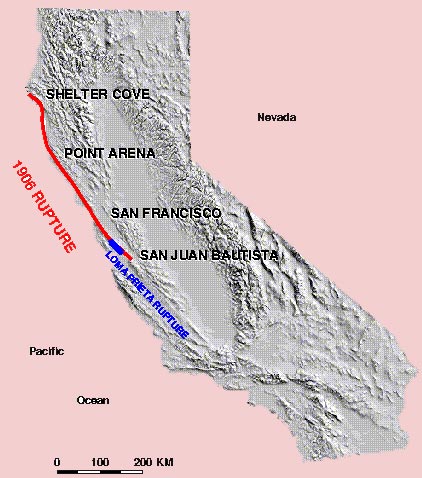





























 1917,
APRIL 1
1917,
APRIL 1





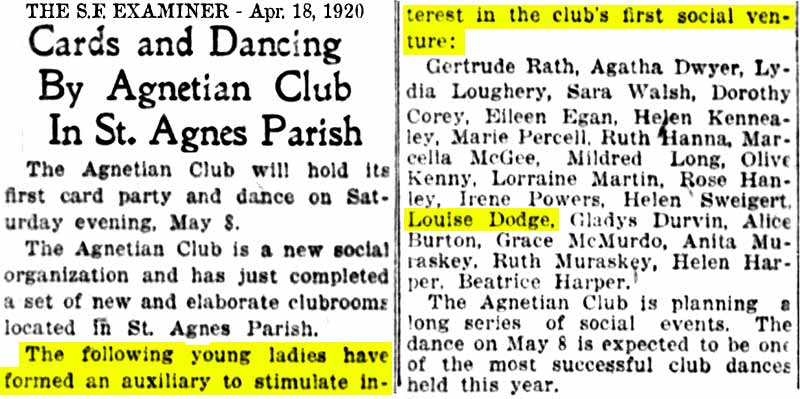
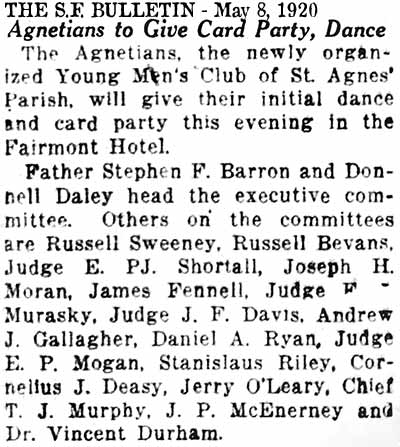
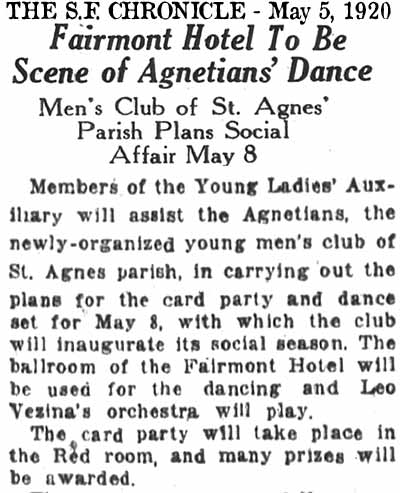
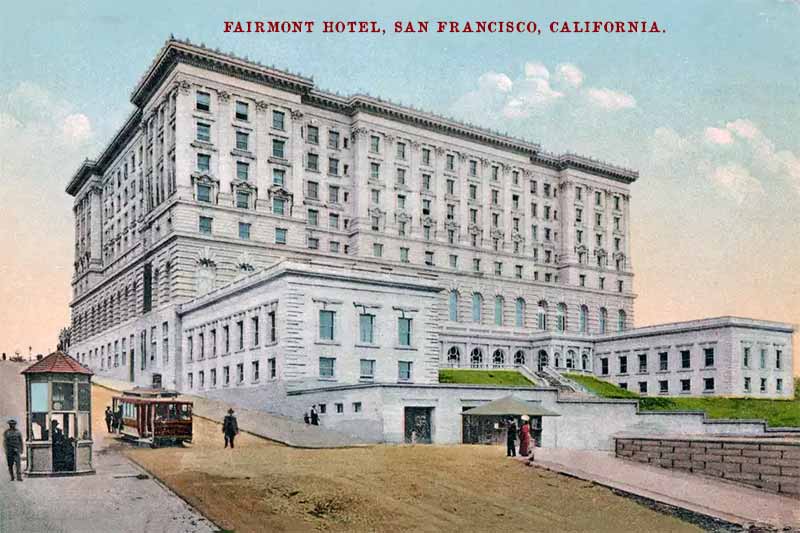




.jpg) Louise's
father died on Apr. 29, 1925 according to the
California State death index; he was 89.
After the death of his wife, he entered the Old
Soldier's Home in Yountville. He was
described as "Dr. David A. Dodge, retired
Presbyterian minister and Civil War veteran and
not regularly attached to any Berkeley church,
he many times preached from local pulpits.
He was a captain of Co. I, 18th Michigan
Infantry and member of Lookout Mountain Post 88, G.A.R. of Berkeley. G.A.R stands for
Grand Army of the Republic.
Louise's
father died on Apr. 29, 1925 according to the
California State death index; he was 89.
After the death of his wife, he entered the Old
Soldier's Home in Yountville. He was
described as "Dr. David A. Dodge, retired
Presbyterian minister and Civil War veteran and
not regularly attached to any Berkeley church,
he many times preached from local pulpits.
He was a captain of Co. I, 18th Michigan
Infantry and member of Lookout Mountain Post 88, G.A.R. of Berkeley. G.A.R stands for
Grand Army of the Republic.

.jpg)
.jpg)
.jpg)
.jpg)
.jpg)
.jpg)
.jpg)
.jpg)





















